|
|
Posted By Melissa Thomatz,
Wednesday, June 21, 2023
|
By Web Editor
October 3, 2021

Interpretive signage at the Morton Arboretum
Chicago is famous for many things, including architecture, deep dish pizza, Navy Pier and Wrigley Field. But did you know that it is also famous for conifers? Conveniently located within non-stop flight range for most of the US, Chicago is a conifer-lover's Mecca. Two world-class botanical gardens, the Chicago Botanic Garden and the Morton Arboretum boast extensive conifer collections and miles of walking, driving and cycling paths. The query posed in the photo above likely referred to the commercial importance of conifers, but we coneheads know that that is only the tip of the iceberg.

A Picea abies loaded with seed cones at the Morton Arboretum
The Morton Arboretum
The Morton is big - 1700 acres - and it follows that the plants are big, too. It lives up to its designation as an arboretum and there is little frou-frou flower finery on display, although the entrance and visitor center are nicely and decoratively landscaped. The conifer garden includes some good sized specimens of species trees, including a group of Pinus virginiana that have enough age on them to display some seriously decorative bark.

One of the group of mature Pinus virginiana in the conifer collection at the Morton Arboretum
What the Morton lacks in fancy cultivars and heavily planted beds is miles and miles of driving and walking trails throughout the mostly-forested arboretum. It was easy to visit by driving along the main arteries and stopping at the frequent pull-outs to inspect trees more closely or just to walk around and enjoy being among the trees and under the canopies. This is an outdoor-lovers garden, a place to take a picnic or a stool and a sketchbook. There is so much room that it is easy to find a spot of one's own. The huge numbers of spring-flowering trees make a return visit in April or May almost a command performance.

Abies nordmanniana 'Tortifolia'
There were some cultivars on display, however, planted in or next to mixed beds in other areas of the Arboretum (i.e. not in the designated conifer garden). The specimen of Abies nordmanniana 'Tortifolia' (twistleaf Nordmann fir) was lovely, as was the Pinus densiflora 'Oculis Draconis'.

Pinus densiflora 'Oculis Draconis' (Oculis Draconis Japanese red pine)
In short, if you are near Chicago and are longing for wide open spaces, soaring trees, expansive lawns and miles and miles of roads and trails, don't miss a trip to the Morton Arboretum. You don't have to be a conifer lover or even a tree lover. There is a four-acre children's garden and a one-acre maze. The leaves are about to start turning, so don't waste time planning your trip! Oh, and as an extra bonus, they have one of the best gift shops I've ever seen at a botanical garden.
The Chicago Botanic Garden
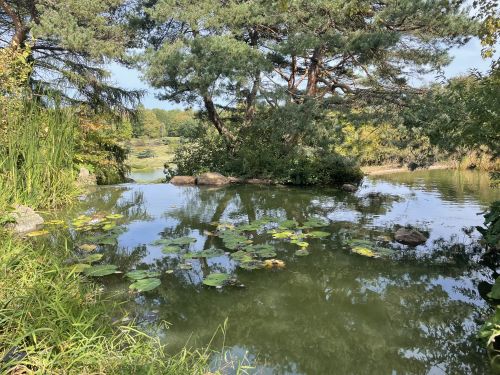
A waterlily pond in the Conifer Garden at the CBG, watched over by a stunning Pinus densiflora
What the Chicago Botanic lacks in comparative size (it's 385 acres, so it's not small), it more than makes up for in how jam-packed that space is with choice plantings. Situated on nine islands in the Cook County Forest Preserves, just inland from Lake Michigan, it's a stunning site that is so full of marvelous specimens that you might have to go back to the Morton Arboretum to rest your eyes after visiting! While making what we thought was a bee-line to the Conifer Garden, we found ourselves captivated by the perennial garden outside the visitors center, called the Crescent.
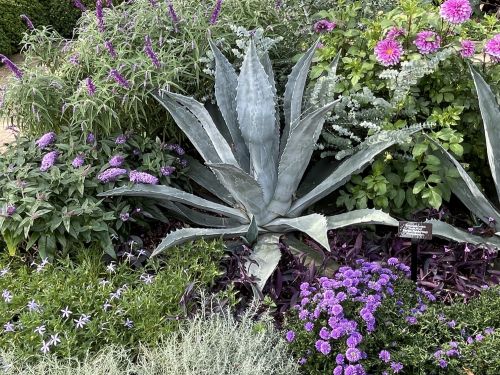
An Agave coexists edgily with Salvia, Buddleia and other herbaceous perennials in the Crescent
It's rare that tree lovers find themselves unable to tear themselves away from seasonal color, but the combinations of hues and plants in these beds are both harmonious and edgy, catching the observer in the tension between soft blooms and toothy agave leaves, and between rich purple leaves and silvery spikes. This is a sophisticated perennial garden, one that demonstrates what can be done with a fearless approach and a deft eye. This creation is by Liz Rex, one of the Garden's staff horticulturalists.

Seed cones on Tsuga canadensis 'Kelsey's Weeping' in the Dwarf Conifer Garden
The Conifer Garden at CBG is one of the best collections of dwarf cultivars in a public garden. The specimens are healthy, well-placed and have enough age on them to demonstrate what that little plant that you saw at the nursery in the three gallon container will look like after a few years in the ground. The paths are ample and easy to navigate and allow you to get up close and personal, making it easy to see details, such as the lovely profusion of cones depicted above. You can read more about it on CBG's website.

Pinus sylvestris var. hamata (syn Pinus sosnowski)
The Dwarf Conifer Garden is on a hill overlooking the Japanese Garden, which is on its own island. Past the conifers, pools of water spill down the hill, rushing through rocky crevices with a roar that is audible throughout. The Garden is framed by a series of Scots pines (Pinus sylvestris), most of which are open enough (or begin branching high enough) to provide glimpses of the Japanese Garden beyond. Even on a hot day, the shade of the pines and the sound of the water are cool and refreshing.

The Japanese Garden has stylized conifers in a formal layout
You could easily spend a day at either garden. The conifers are wonderful, but both gardens offer much more. At a time when many of us prefer to interact with others out of doors, Chicago may be your kind of town.
This post has not been tagged.
Permalink
| Comments (0)
|
|
|
Posted By Admin,
Wednesday, June 21, 2023
|
By Web Editor
November 23, 2020

Who doesn't love the brilliance of fall color as deciduous trees and shrubs settle into dormancy? They sure don't go quietly into that good winter. One of the wonderful aspects of using conifers in the landscape is that they seamlessly move from star players to supporting cast. In this shot, 'Lime Glow' barberry is sheltered by the weeping branches of a large Juniperus cedrus (Canary Island juniper) and sits in front of a Picea omorika 'Pendula Kuck' (Kuck's weeping Serbian spruce). The greens from the conifers (and from the other evergreens) set off the flaming barberry foliage for maximum impact.

Another shot of the same Berberis.
In this shot of the same clump of barberry, the shrubs are sandwiched between the yellow leaves of an Acer pseudoplatanus 'Nizetii' and a group of Agave geminiflora 'Spaghetti Strap'. Other conifers in the scene add more green and cool off the hots. It's not nearly as rich or interesting if you leave out the conifers:
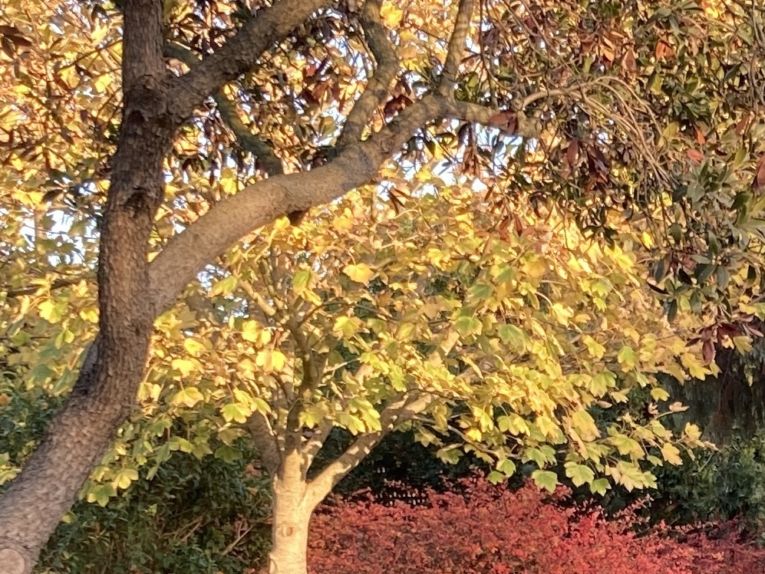
Red and yellow provide heat, but not contrast.
Finally, here is the stand of barberry from a distance, looking like coals glowing in a hearth of conifers. The barberry gets star billing twice a year: in spring, pushing new foliage, and fall, when it ignites. In summer, it is a reliable background for other plants. It takes winter off. The conifers, on the other hand, work all four seasons!

Viburnum opulus 'Roseum' turns salmon-pink in autumn
Most people fall in love with the flowers on the snowball bush, which, like the barberry, gets two starring seasons. For this gardener, the fall color is even better than the flowers, as that pinky-orange is hard to beat. This plant is situated between a Cedrus deodara 'Snow Sprite'on the left and a Pinus heldreichii 'Satellit' (satellite Bosnian pine)on the right. Both conifers have a blue cast to their needles, making this combo very different in tone than the red-green of the previous grouping.
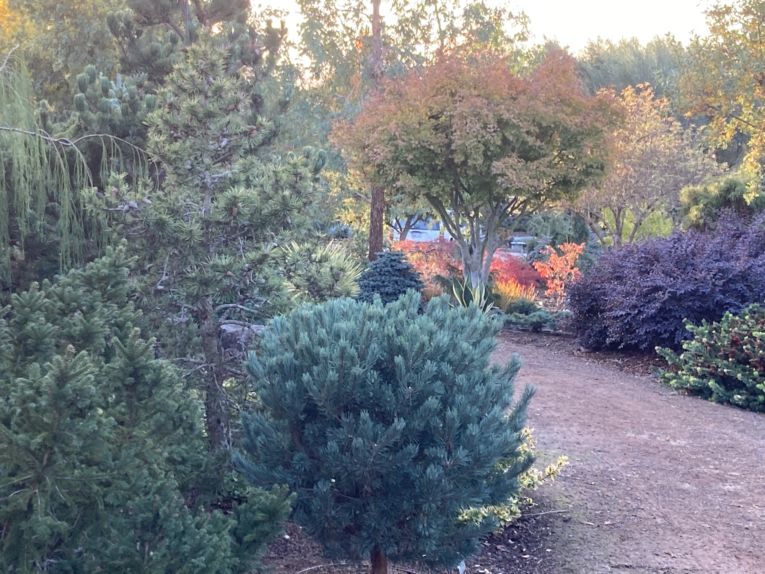
Another glowing hearth, this time the coals are Japanese maples, Libertia and Euonymus
Jewel tones abound in this shot, with a Pinus sylvestris 'Watereri' providing the emerald, Loropetalum chinense Ever Red, the amethyst and a PIcea pungens 'Waldbrunn' (in the background, above the 'Wateri') the sapphire. Rubies and citrines make up the background fire, crackling away in the hearth.
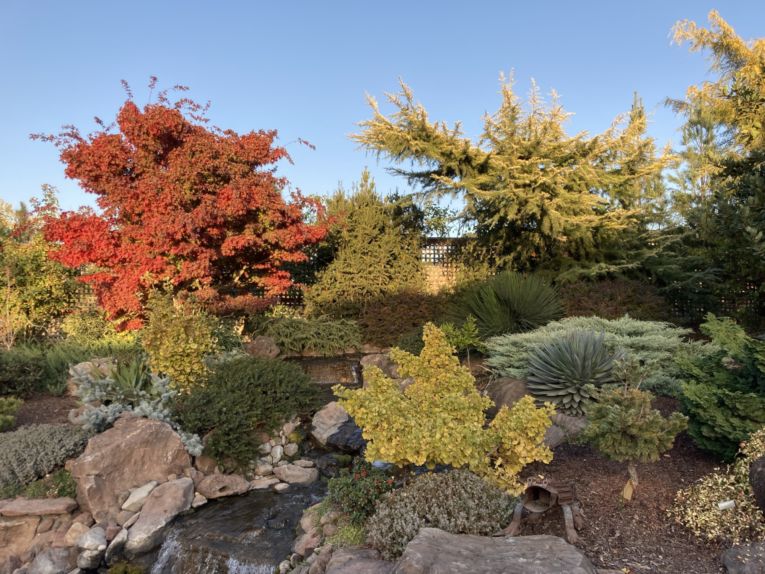
Sometimes the diva claims so much attention that the rest of the cast can't compete
The Acer palmatum 'Tobiosho' in the shot above is in the opera's final act, and the diva is going out with a flourish. Normally a sedate, well-behaved player, it leaps into fall, almost overnight, with such pizzazz that it is difficult to take your eyes off it. One of the reasons that fall colors display themselves so pleasingly is due to the effect of the low, soft light, which allows the colors to blaze without being washed out by the relentless, overhead sun of summer. This shot, taken late in the afternoon, shows what happens when you train a spotlight on deep orange-red. In another month, the maple, and the two Ginkgo biloba (L to R: 'Troll' and 'Gnome') will have lost their leaves and the conifers and succulents will carry the whole show. Right now they have to step out of the spotlight.
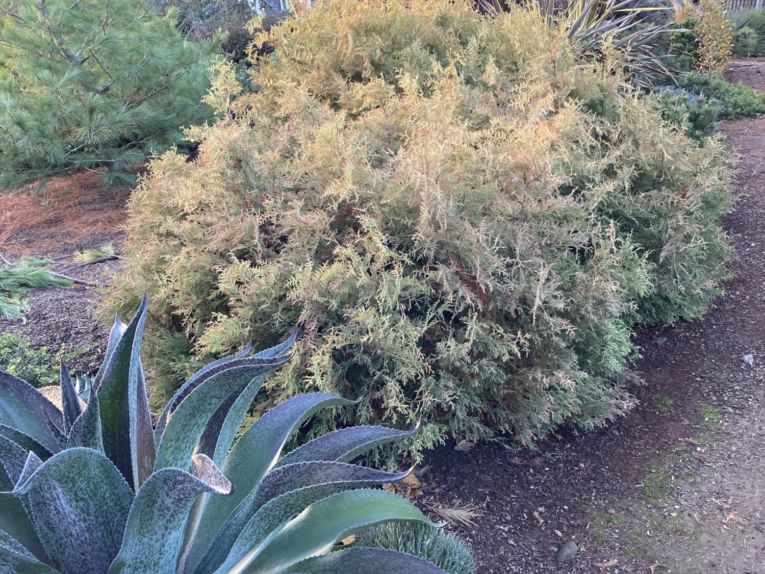
The exception that tests the rule: Thuja occidentalis 'Rheingold'
So the premise of this article is that conifers make a great foil for dazzling deciduous fall foliage, right? But not all conifers are content to leave the limelight to their angiosperm brethren. Take a look at Rheingold arborvitae above. An attractive soft gold for much of the year, it adds texture and interest to mixed plantings of conifers and other woody plants. But in winter, the color becomes more pronounced and other plants have to take a back seat. In the above pairing, the x Mangave 'Inca Warrior' to the left is generally the eye-catcher, due to its almost metallic structure and sheen. But the ever-deepening gold on the arborvitae allows it to take its place as an equal member of the eye-candy club. Now that colder weather has driven many gardeners inside for the winter, it is a great time to evaluate what works and what doesn't in your garden. If you don't have conifers and evergreens, think about how adding a few would give your garden not just more winter interest, but more autumn interest as well. Think about pairing deep greens, blue greens, and even golds with the other colors in your garden. There are over 5,000 dwarf conifer cultivars. You are sure to find the perfect ones for you!
This post has not been tagged.
Permalink
|
|
|
Posted By Admin,
Wednesday, June 21, 2023
|
by Web Editor
Mar. 29, 2013

When we went out in the garden this week we couldn't help seeing Easter eggs everywhere....delightfully dyed in pastel Pascal colors. Pinus parviflora 'Cleary' caught our eye immediately, with its clutches of tiny, vivid magenta ovoid eggs are sprinkled over the branches of the Korean fir Abies koreana 'Horstmann's Silberlocke' - those cute little things couldn't really be cones, could they?

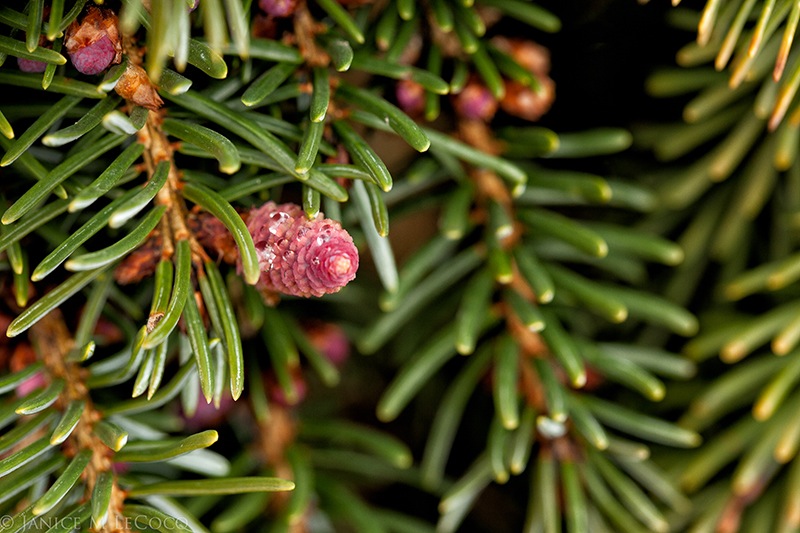
Raspberry colored egg-like cones grace the branches of Picea omorika 'Pendula Bruns'
Tall, hulking Picea omorika 'Pendula Bruns' has some of the most delicate cones, which are small-sized even when mature. They make up for lack of stature in sheer number; this 'egg basket' of a tree, which is only about 6' tall, has hundreds of cones on it this spring.
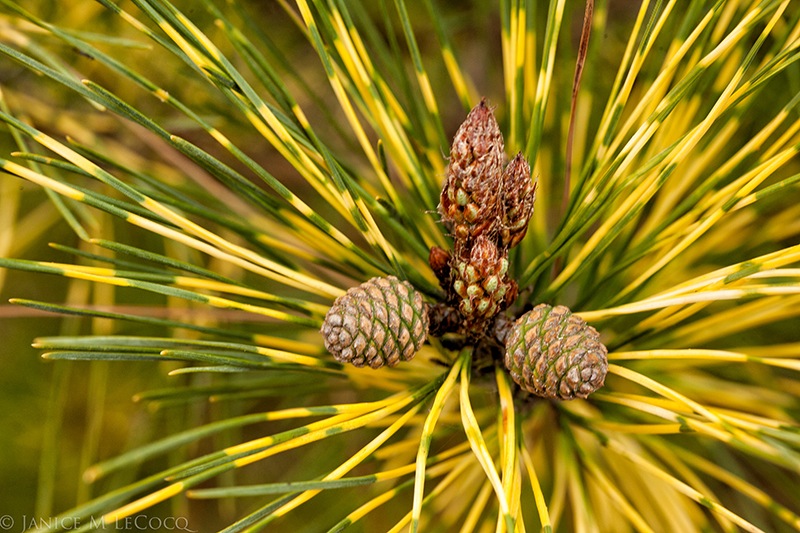
Pinus densiflora 'Golden Ghost' is all decked out for Easter in a yellow spring coat, and holds a brace of deeply etched eggs in this clutch. It's hard for anything to compete with that incredible, dramatic foliage!
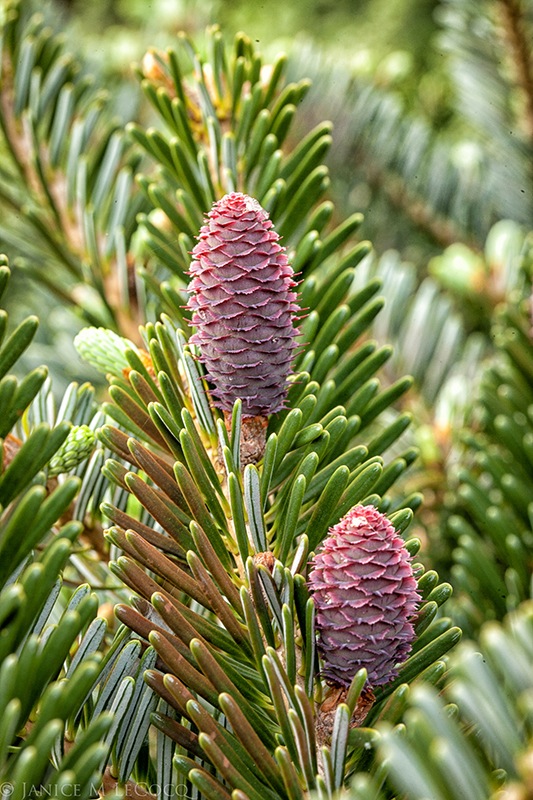
Normally a subdued and dignified shrub, Abies arnoldiana 'Poulsen' indulges in attention-getting behavior by producing cones in the most outrageous shade of deep raspberry imaginable. It's hard to believe that the Easter Bunny was willing to part with these!

And what's an Easter Basket without jelly beans? Sedum rubrotinctum sure fits the bill. In warm weather the 'jelly beans' turn green with just a few hints of red, but cool winter and early spring temps bring out the bold red. Perhaps cinnamon-flavored? Now the only thing that we're left wondering is if that huge jackrabbit we startled this morning was really the Easter Bunny...
This post has not been tagged.
Permalink
|
|
|
Posted By Admin,
Wednesday, June 21, 2023
|
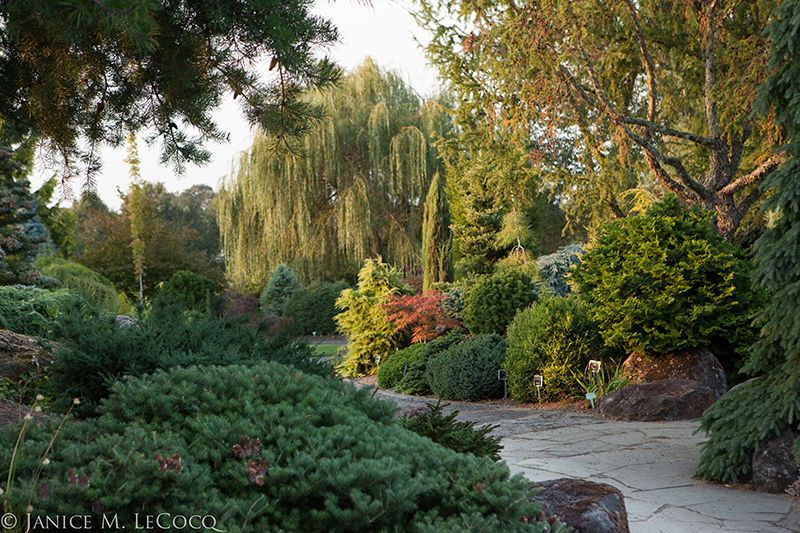
A Destination Resort is one whose location and amenities make the resort itself an attraction for tourists, rather than just a spot to stay while visiting the region. For Form and Foliage, The Oregon Garden Resort provided the best amenity of all: The Oregon Garden! And an unexpected bonus was that The Garden is open before/after hours to those staying at The Resort.
Thus, we were able to wander at will before the crowds arrived and after they had gone home and catch the best light of the day.
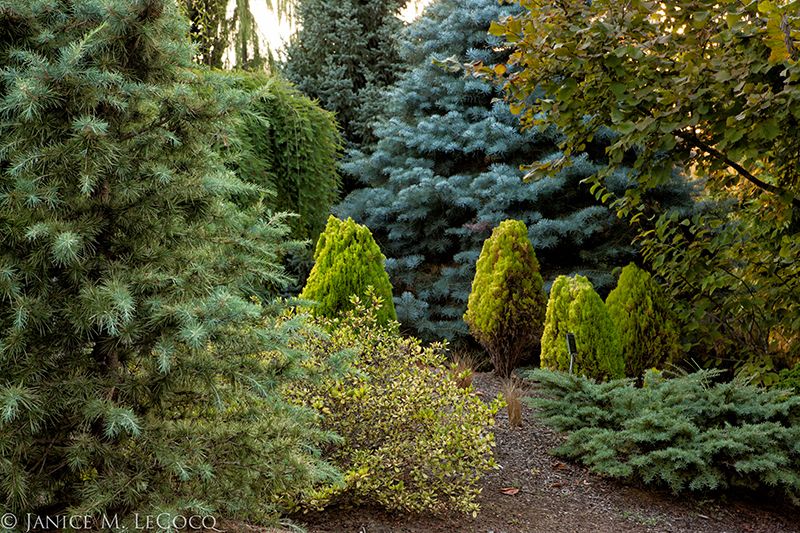
We spent most of our time in the Conifer Collection, which features not just conifers tastefully planted but also a nice selection of companion plants. The Garden was the brainchild of the Oregon Association of Nurseries as a way to showcase the State's rich horticultural heritage. Groundbreaking was in 1997 and the Conifer Garden was dedicated in 2000, although the plantings feel like they have been in the ground longer than the intervening 12 years (our visit was in September 2012).
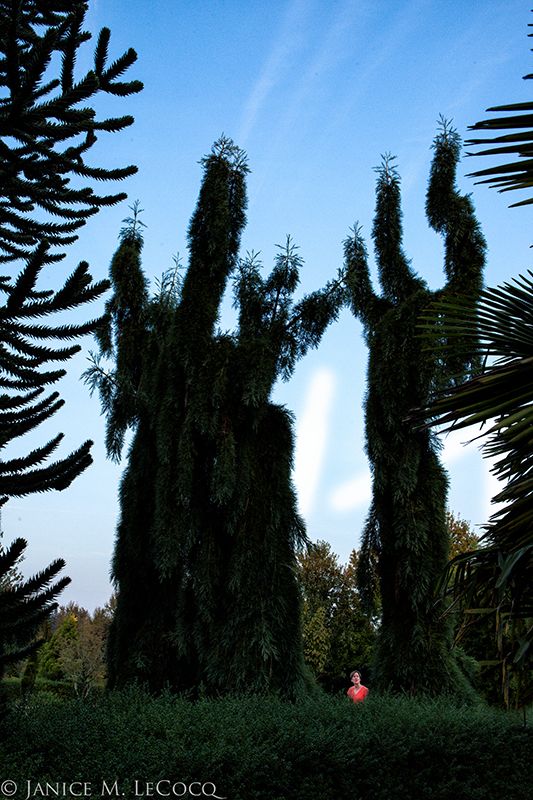
The Conifer Garden has one of the largest collections of dwarf and miniature conifers in the U.S. and was created in partnership with the American Conifer Society, which provides ongoing consultation. We hear that there are plans to double the Conifer Garden's size so we're calendaring a return trip!

We used The Resort as our home base while we were visiting nearby nurseries and private gardens and thus were able to see the gardens over several days. There was no shortage of plantings to observe, and we were particularly taken with the mix of conifers and companion plants, which showcased the best attributes of both, such as the juxtaposition of the blue spruce and orange heather in the above photo.

The same blue/orange combination (which we've written about before in We've Got the Blues) works with softer tints as well, as you can see in the above photo. Clearly this garden was planned with an eye to both color and seasonality.
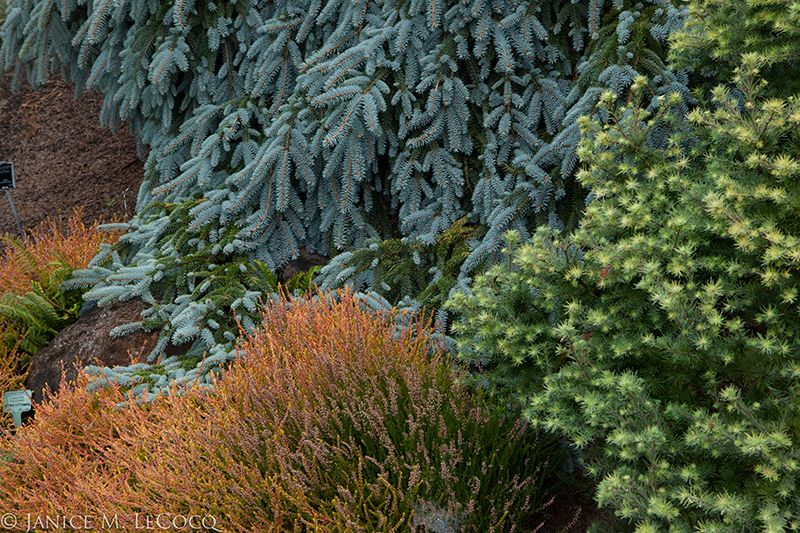
Weeping blue and upright orange combine with starry mint green for a rich combination of colors and shapes The planners were attentive to shape, as well, as tall weepers flow into upright ground-huggers with staccato bursts of bright foliage keeping things lively. This garden provides many take-aways for the home gardener in design, plant selection, and plant combinations.
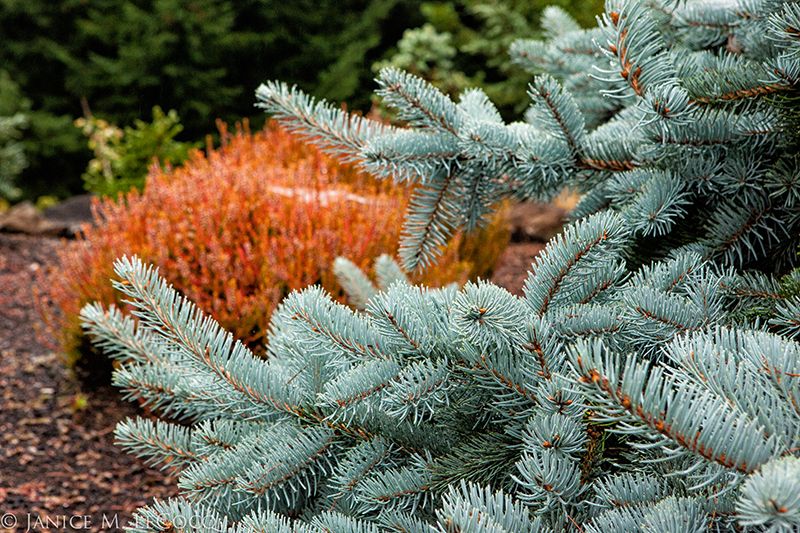
We couldn't resist one last artsy shot of the power that the blue/orange combination provides!
The color combinations in the garden go way beyond that pairing, however. The palette encompasses many shades of greens, yellows and reds and maroon.

In the above photo the maple in the foreground tries for drama while the conifers provide a range of color, even in autumn when they are not flush with new growth. Everyone that thinks that conifers are boring should take a long look at this scene, and remember that they will look like this all winter, too...
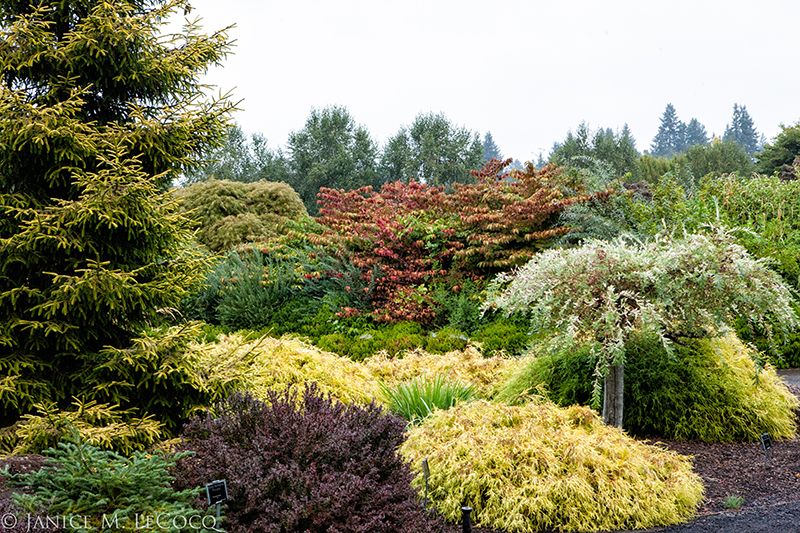
The above scene shows another side of conifer color - the 'pop' that yellow and gold can provide in a dreary winter landscape (see Bleak Midwinter). The lemony yellow of the billowy weeping Chamaecyparis is picked up by the tips of the spruce on the left. While the maroon Berberis in front and the fiery Viburnum in the rear are still in leaf there is even more garden color - in autumn.
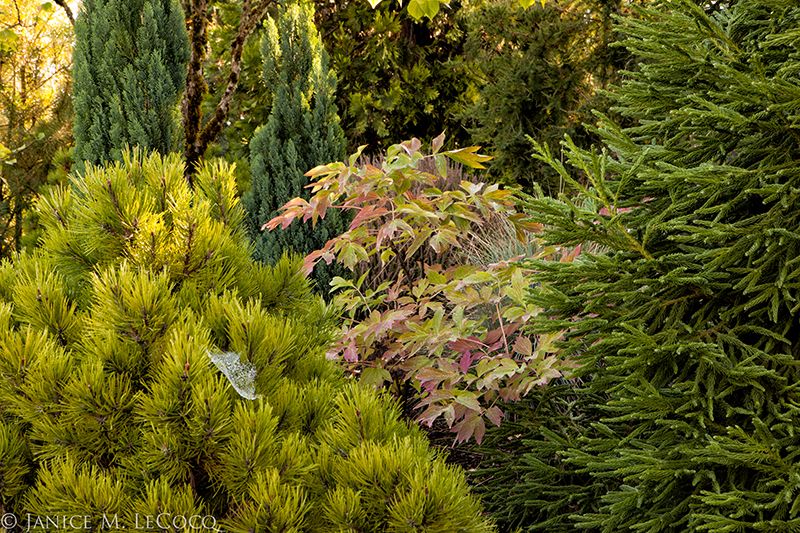
One of the things that makes this garden such a pleasure to visit is the use of such a broad selection of plant material. The fairly pedestrian peony in the above photo, which most people plant simply for the sumptuous spring flower, has raspberry-stained leaves in autumn and provides a subtle accent to the many shades - and shapes - of the surrounding conifers.

The conifers are interplanted lavishly with beautiful specimen trees, chosen for their form and foliage (see why we liked it?) The weeping purple beech above shows off the cedar in front with lovely contrast of color, shape and texture. The tree trunks will continue to provide structure and contrast when the leaves have fallen.

We loved staying here at The Garden and would recommend it as a relaxing spot for anyone wanting to see a superb - and beautifully planted - conifer collection. Even non-gardeners will find much to admire and enjoy at The Garden, and the ability to wander freely when it is closed to day visitors makes this garden experience more like staying at a private country manor than visiting a public installation.

From here we visited a private garden that has some breathtaking plantings, so stay tuned...in the meantime, take a look at The Oregon Garden and start planning your visit!
This post has not been tagged.
Permalink
|
|
|
Posted By Admin,
Tuesday, June 20, 2023
|
By Web Editor
July 11, 2020
Editor's note: This entry was not written by me. It was submitted anonymously by a director who specializes in conifer gardens. The author has primarily worked on indie productions, often working with a low budget and local talent, creating scenes that rival professional films in beauty, color and grandeur. We can't wait to see the sequels!

Pinus bungeana (lacebark pine) is a character actor, ready to grab the leading role in summer
There are many parallels between a movie director and a gardener. Think of your garden as a movie set which has 365 different scenes to be viewed each year. Each daily scene must be planned, staged and completed, to ensure a year of viewing pleasure. Just as with a movie, you don't want every scene to be a high intensity “action sequence”. How about some quiet or romantic interludes? You certainly want to have something worth admiring each day of the year, especially your garden's most select vistas. There are days requiring a special view to celebrate an important occasion. Treat those dates as critical scenes, which require research, advance planning and special attention to put you in the running for your garden Oscar!

Tsuga canadensis var. pendula works well with a supporting cast of extras, including hostas, ferns and Brunnera
We'll jump into this garden movie mid-year, as summer is fully upon us. The new growth flush has finished, the conifers are now sharing the spotlight with others, yet still command attention. Their wide range of colors, textures, shapes and sizes make them an indispensable part of scene composition. If you, as director, are careful to provide the drainage (sometimes mounds or raised bed are a necessary part of the set) and the sunlight they require, they are generally reliable performers in summer and work well with other companion plants with similar cultural requirements. The weeping hemlock featured above underplays its role as the dominant character in the scene, allowing the supporting cast to shine in a shady location.
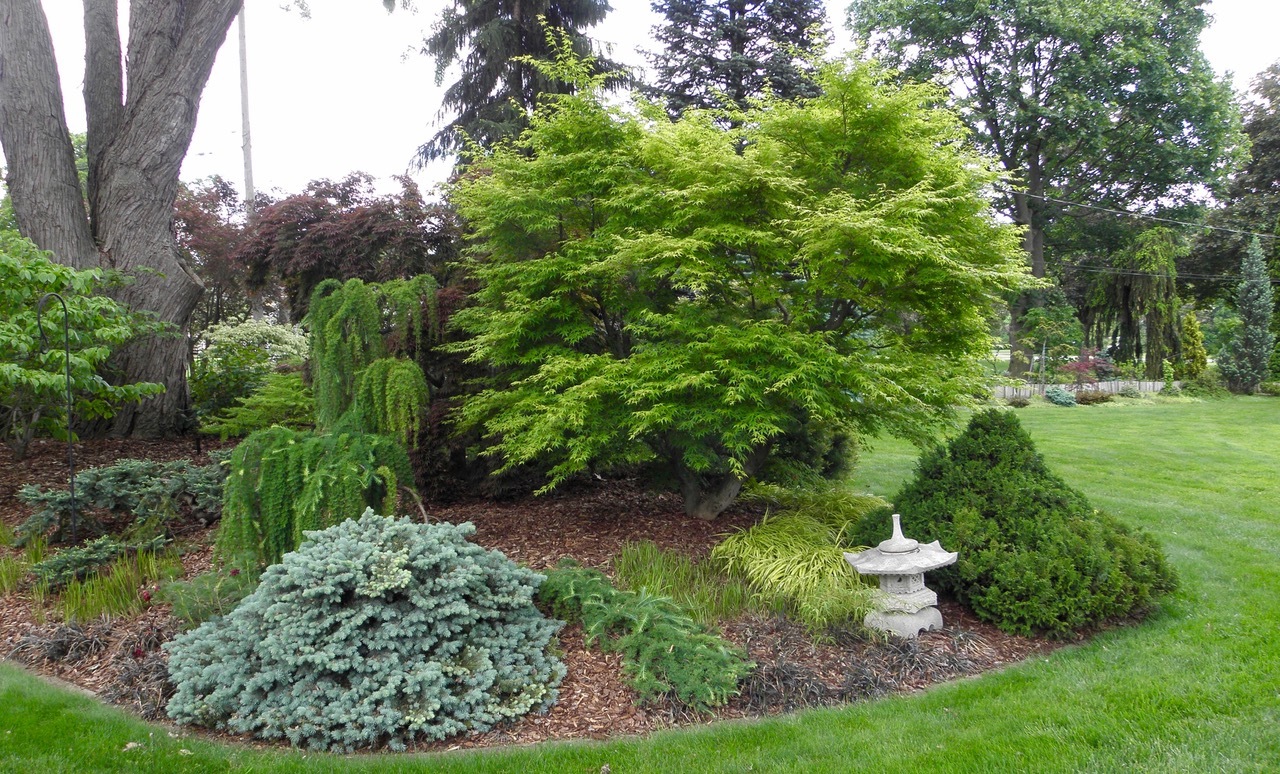
Larix kaemferi 'Pendula' and Picea pungens 'St. Mary's Broom' claim center stage in summer, assisted by supporting cast
You will need some character actors, stars, supporting cast, bit players and likely some “movie props” in your garden drama. Some of your potential actors might be high maintenance divas and you will have to decide if the effort is worth their contribution. Shapes, sizes, textures, and growth rate are important elements in the cast selection process. Just as actors must have “good chemistry” to successfully perform together, you must similarly pay attention to cultural requirements to achieve good outcomes as you mix your conifers with companion plants. Finally as part of your ongoing maintenance, you may find the need to retire some actors and bring in some promising new talent.
As the film rolls through the summer scenes, the conifers continue to add value and texture. Go out and view your own garden 'movie' and hone your directorial talents. Not all the at-home drama is playing on Netflix these days!
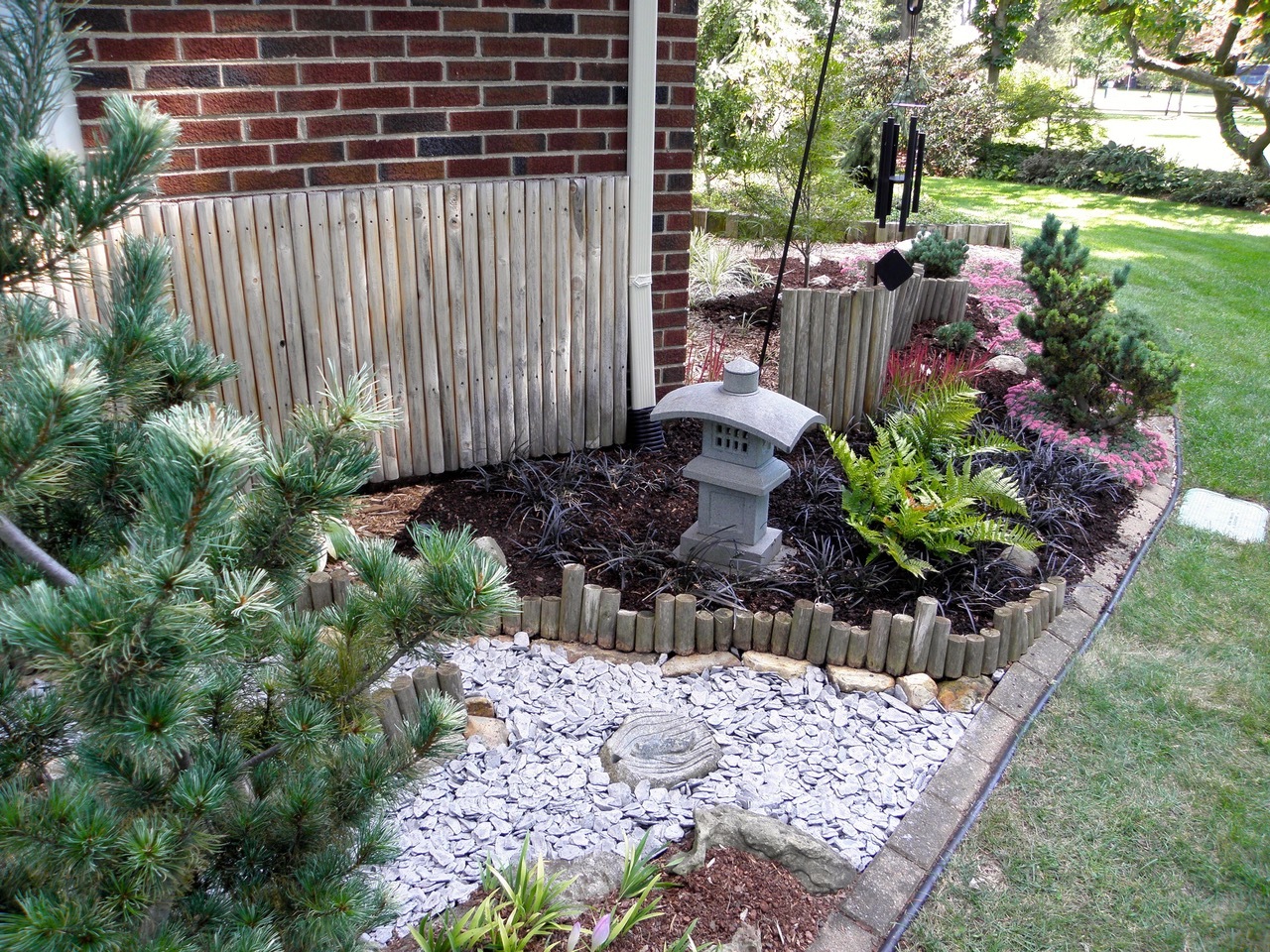
Pinus parvifloras ‘Tanima no yuki’ and ‘Kinpo’, Hylotelephium cauticola ‘Lidakense’ and Ophiopogon planiscapus 'Kokuryu'
In the late-summer shot above, the conifers provide a cooling influence to the more dramatic black mondo grass and pink-flowering sedum. All of these actors come to us from Japan, and the staging has been designed accordingly.
Coming to a blog near you in September: Autumn!
This post has not been tagged.
Permalink
|
|
|
Posted By Admin,
Tuesday, June 20, 2023
|
By Web Editor
June 23, 2014
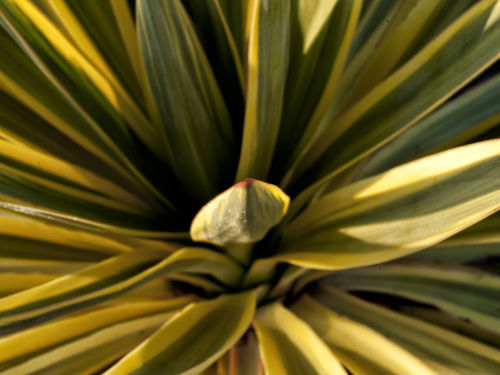
Yucca gloriosa var. recurva 'Walbristar' (bright star yucca)
We've long intended to provide plant lists for readers, with criteria such as 'most durable', 'best winter interest', 'prettiest, etc. However as we begin to assemble the lists, we find that the easiest one to create is the list of plants that we simply can't imagine being without. These aren't the hardiest or the prettiest or the most drought-tolerant, they're the go-to plants that both do the job and look like they are doing it effortlessly. This list is from the perspective of a long-time San Francisco Bay Area gardener, so may not apply to your situation. However, others' lists are simply excuses to create your own, so if you don't have a 'must have' list already, this is your chance to begin! We will note up front that all of these selections are more expensive than many other plants of similar look and size. However, they are worth it! Plants that behave well, that do not readily outgrow their spaces, are not susceptible to pathogens or predators and have long lives should cost more. How many cartloads of perennials do you really need every season? Forego one of them and buy a special plant instead.

1. First on our list is Yucca gloriosa var. recurva 'Walbristar' (Zone 7-10), quite a mouthful so easier, perhaps, to simply think bright star Yucca. We used to use Phormiums extensively, and gradually got tired of reversions (when those glorious colored or striped leaves return to dull green), growth rates far beyond the promises on the tags and difficult upkeep. One of our favorites had been 'Golden Ray', which features yellow and green striped leaves and thrives in full sun. Once we discovered 'Walbristar', however, we turned our back on Phormiums and have never looked back! 'Walbristar' has both a more refined look and more refined colors, the leaves do not shred and brown and it develops a distinctly rosy tint in the winter:
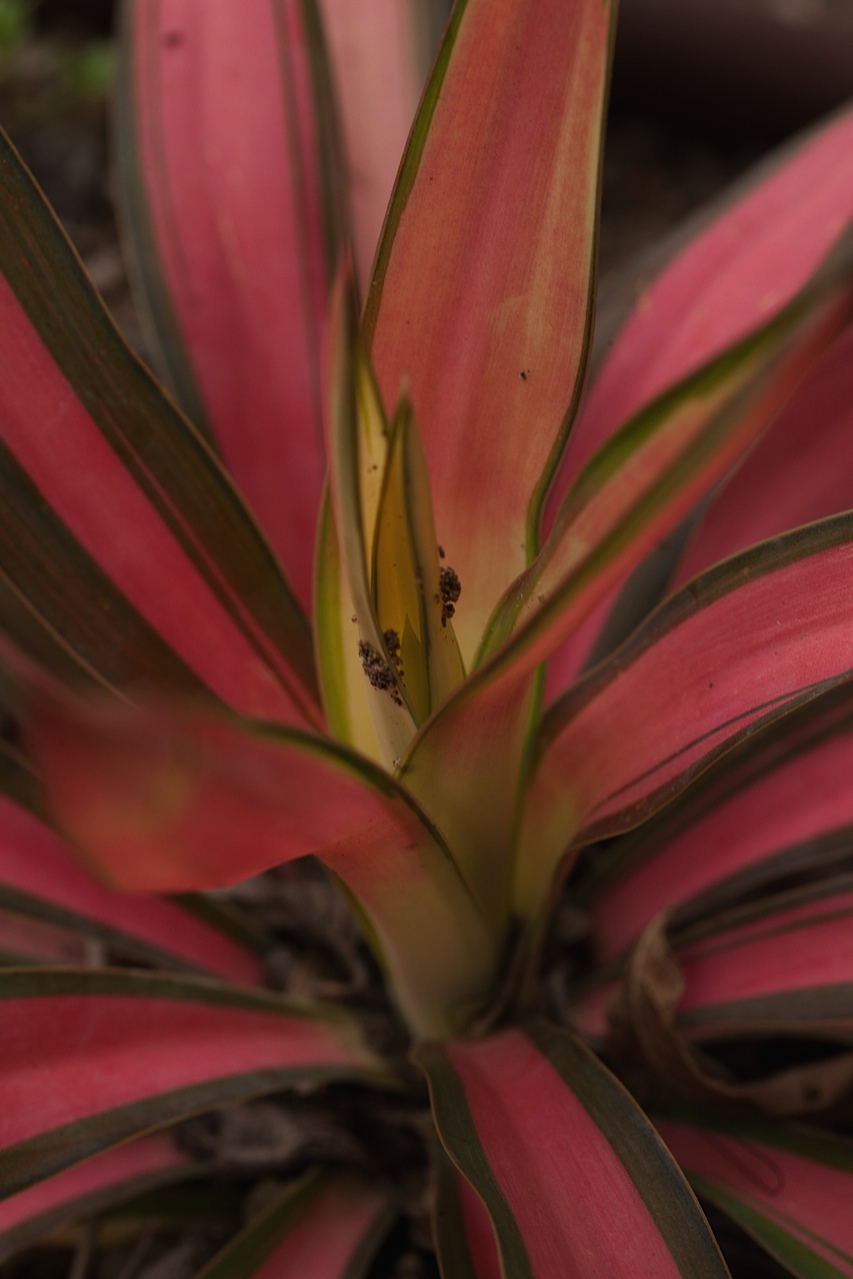
Yucca 'Walbristar' turns rosy in cold temperatures
It's drought tolerant, thrives in most soils and needs little to no upkeep. So far all we've had to do is to cut off a few spent flower stalks. It's smaller 'cousins' Yucca filamentosa 'Color Guard' and Yucca gloriosa 'Tiny Star' have many of the same attributes with a smaller profile (and 'Color Guard' is clump-forming).
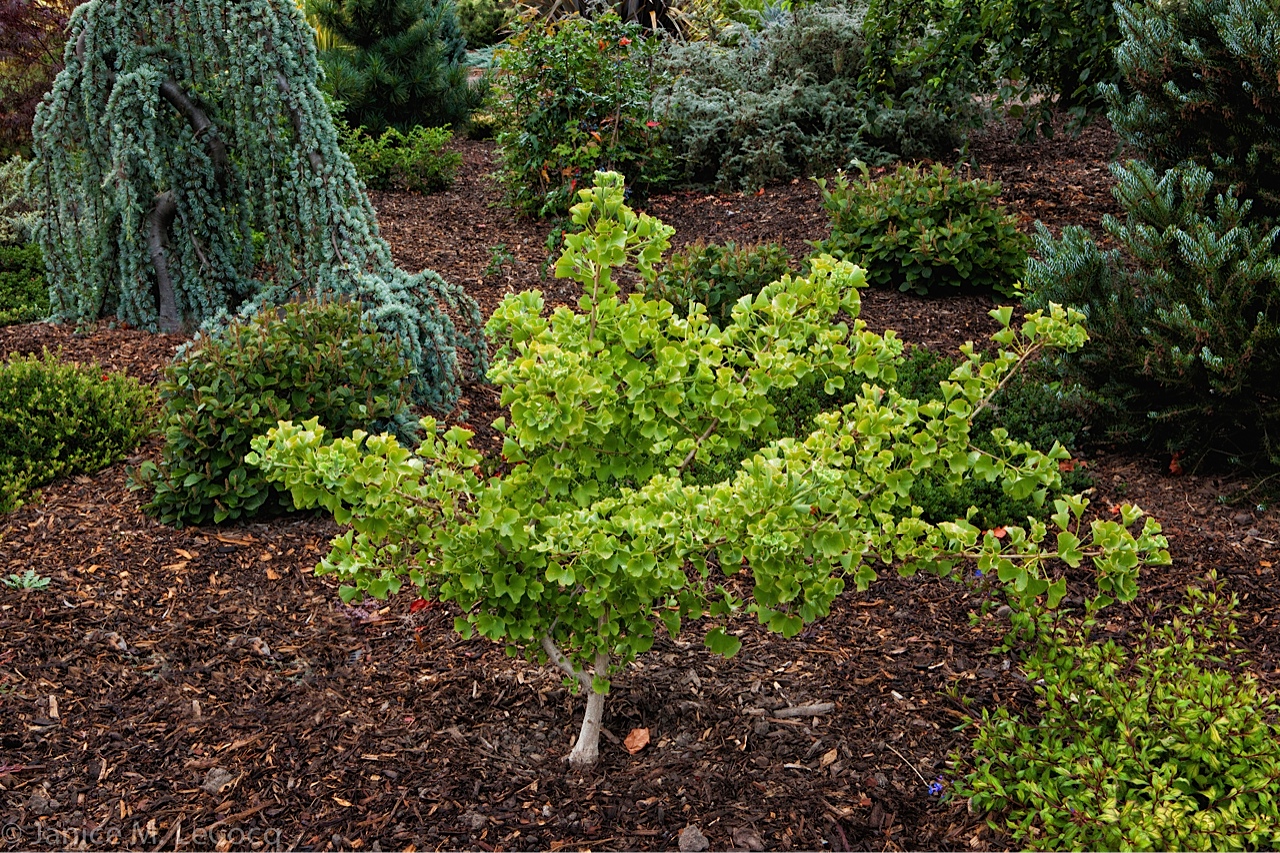
Ginkgo biloba 'Todd's Dwarf'
2. Next is dwarf Ginkgo biloba cultivars (Zone 3-10). Ginkgo are ancient trees that have barely changed over the millennia. Where they have changed, man has been the manipulator, cultivating naturally occurring mutations and interesting chance seedlings and producing numerous garden-sized small trees. The species Ginkgo, albeit slow-growing, attains heights of 70-80 feet, while these petite versions are often under 4' at 10 years. They have interesting branching and leaf variations although all retain a semblance of the iconic 'butterfly' leaf shape. Our favorite is 'Todd's Dwarf, due to its full habit ruffled leaves, but there are many others, such as 'Mariken', 'Troll', 'Munchkin', 'Jade Butterfly' and 'Chase Manhattan'. They all turn butter-yellow in autumn and generally drop their leaves all at once, making a glowing carpet. Four of these tough trees survived the atomic blast at Hiroshima, and they can withstand heat, cold, drought and pollution. They are some of the easiest care, low maintenance garden plants.

Cedrus deodara 'Cream Puff'
3. The lovely deodar cedar 'Cream Puff' (Zone 7-11) is one of the best medium-large evergreen shrubs for Bay Area gardens. The soft, green needles are a classic deodara feature, in this cultivar augmented by creamy white new growth that glows in the landscape, especially during the colder months. Deodara come from the middle East, and deal well with our Mediterranean climate. Once established they are drought-tolerant and can take full sun without any burning or scorching.

Up close, the needles look like they have been flocked or frosted. 'Cream Puff' is slow-growing and can be kept to shrub form, as the one above, by snipping out any leaders that may form.
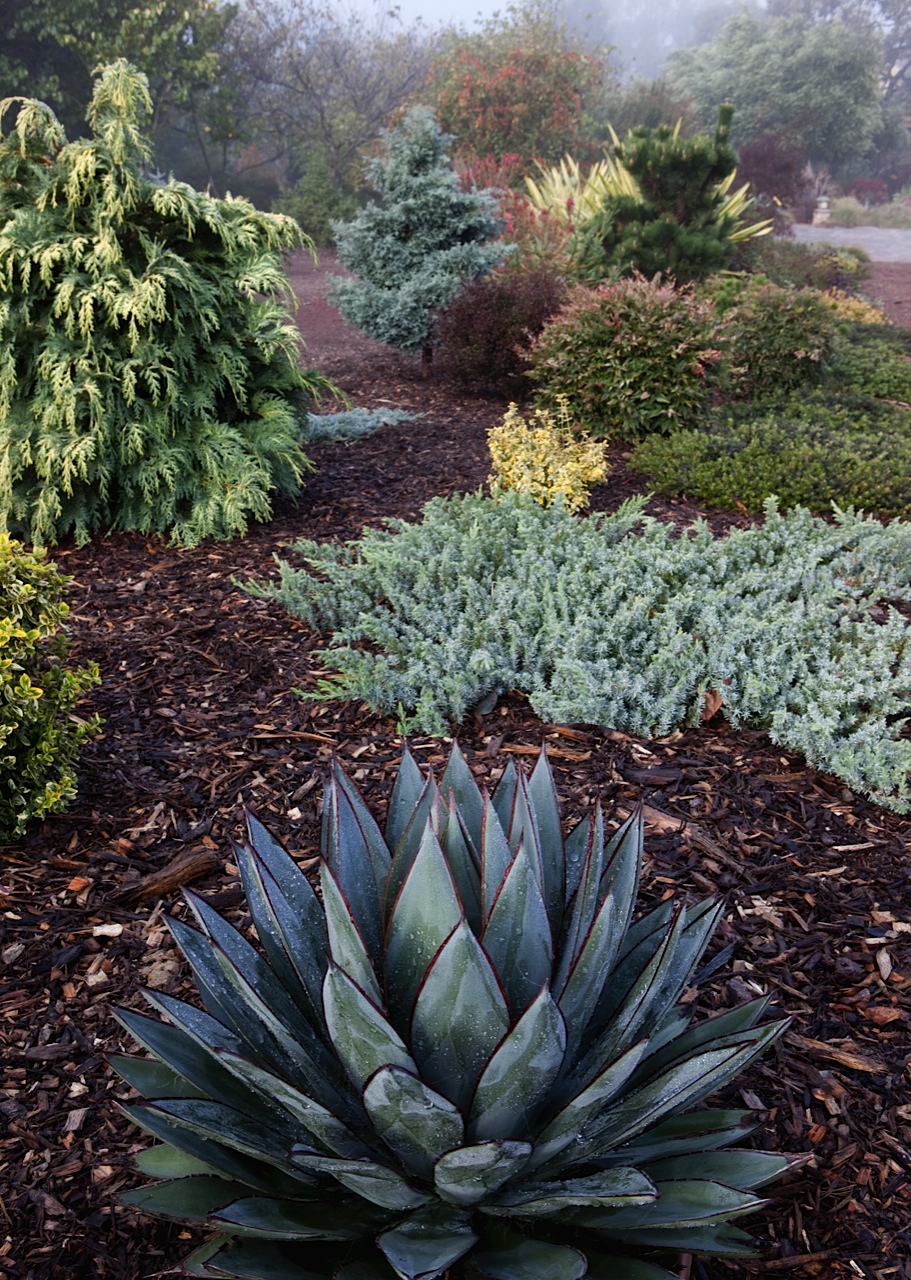
Agave 'Blue Glow'
4. We love our succulents, and rather than relegate them to their own beds, we prefer to choose larger varieties and interplant them into the rest of the garden. Agave x 'Blue Glow' (Zone 8-11) is our very favorite. In the world of Agave, this counts as a small plant, but as you can see, it holds its own amongst many reasonably large shrubs. 'Blue Glow' provides both stunning structure and color and the maroon margins are complemented with maroon-leaved plants such as Berberis, Cotinus or certain succulents. Its water needs are lower than the nearby shrubs, which we take care of by mixing a goodly dose of lava rock into the soil around it and planting it up about 2-3". It's on the same irrigation as the rest of the garden. This Agave will 'pup', or produce smaller plants around its base. The leaf spines are extremely sharp; if you have young children or dogs it is advisable to snip them off with a scissors. It's hard to imagine a plant that provides this much oomph with virtually no maintenance. looks great up close, too:
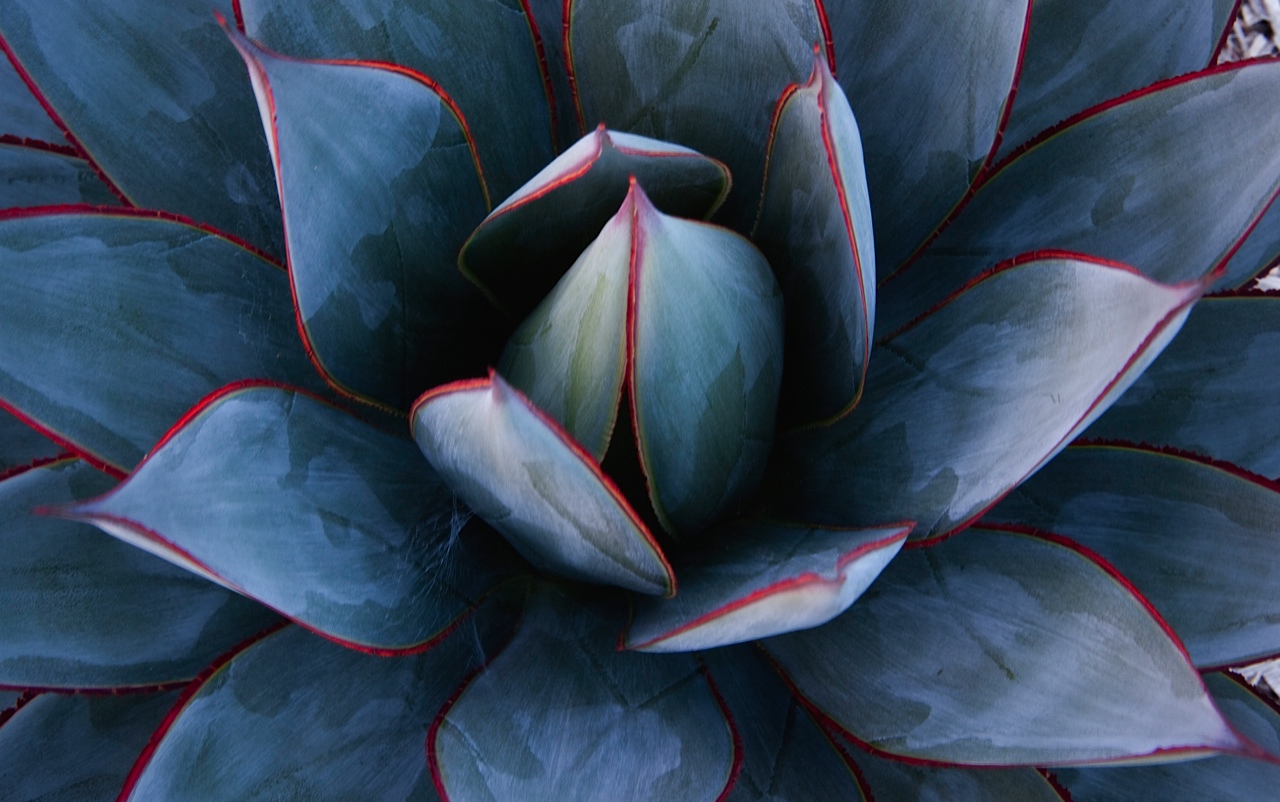
Agave 'Blue Glow'
5. Trees never get enough attention on top plant lists, and there are several that we wouldn't be without. Arbutus 'Marina' (Zone 7-9) tops the list for us because it provides all-year interest, incredible bark, glossy evergreen leaves and decorative flowers and fruit. Give it good drainage and a sunny spot and it will flourish. Judicious pruning can result in fabulous shapes and branching.

The peeling, cinnamon-chartreuse bark of Arbutus 'Marina'
The ancestry of 'Marina' is unknown; it was first observed at a nursery in San Francisco's Marina District and it is likely a hybrid between two species of Arbutus. 'Marina' flowers year-round, with peak bloom in spring and fall, and the fruit persist from yellow immature to red mature fruit, for a very decorative effect. The leaves flush bronze, later maturing to deep green. There is not one part of this tree that is not showy! 'Marina' grows slowly but will eventually become a full-sized tree, so site it accordingly.

Arbutus 'Marina'
6. Osmanthus heterophyllus 'Goshiki' is our favorite variegated evergreen shrub.

Osmanthus heterophyllus 'Goshiki'
At a quick glance Osmanthus resembles holly and is commonly called 'false holly'. There are many lovely green Osmanthus, and we use them extensively, but 'Goshiki' (Zones 6-9) is a special cultivar with its leaves flecked with yellow and cream. The new foliage has distinctly rosy-bronzy tones and the entire effect is light, bright and sparkling. We like to use 'Goshiki' against dark green conifers, where we get contrast of both color and texture. 'Goshiki' grows slowly and while it eventually will attain some size, it can be snipped back easily. Slow growth means that it is much harder for a plant to get out of hand! In this area it benefits from some afternoon shade, but it can be grown from almost full shade to full sun. It is a wonderful way to brighten a dark spot in the garden.

Thuja plicata 'Whipcord'
7. If you like the look of ornamental grasses but hate the mess and upkeep, Thuja plicata 'Whipcord' (Zones 6-9) is your plant. With the fountain-like habit of a large ornamental grass and the no-nonsense low-care attributes of a conifer (which it is!), it is the perfect marriage of style and simplicity. The dark green foliage bronzes in winter, complementing the rusty brown stems. Its mounding, weeping habit is graceful and soft and its pendulous branches move in the breeze. We often purchase special, highly desirable plants and find ourselves walking around the garden, trying this spot or that, never finding quite the right one. We can always find a spot for 'Whipcord'! It seems to fit in anywhere. 'Whipcord' is slow growing but over time will form a 4-5' shrub that is almost as wide. Easy pruning keeps it much smaller, much longer.

Acer pseudoplatanus 'Esk Sunset'
8. Acer pseduoplatanus 'Esk Sunset' (Zones 5-9) is such a lovely tree that we just can't imagine being without it. Sure, there are hundreds--maybe thousands--of beautiful Japanese maples, and we love them all, but to some extent they begin to blur into each other after a while. 'Esk Sunset' is unique. Even the other pseudoplatanus cultivars don't match its incredible flair. The leaves are mottled pale salmon and green, and the coloration varies from leaf to leaf.
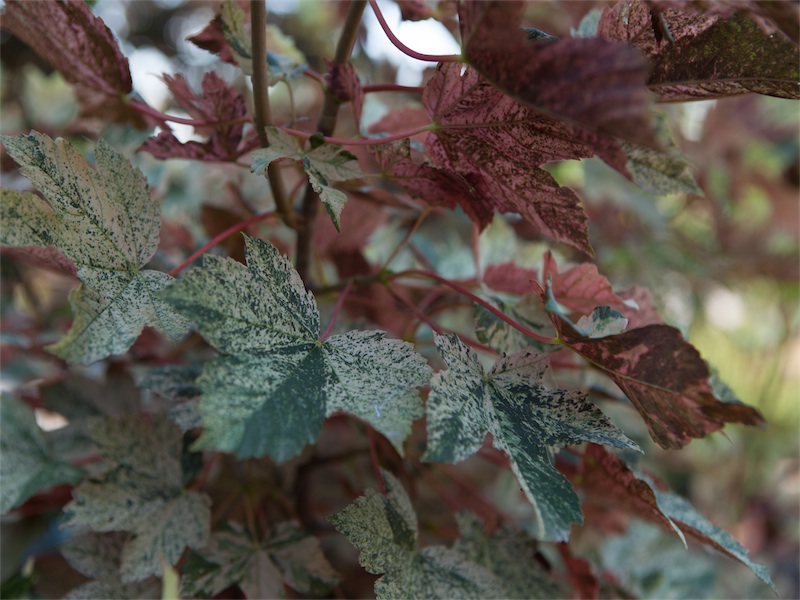
And as if that weren't enough, the undersides of the leaves are purple! When we catch sight of it backlit, we have to stop what we're doing and just goggle at it. 'Esk Sunset' comes from the Esk Valley in New Zealand but some energetic nursery worker decided at some point that 'Esk' was short for 'Eskimo'. Thus, you will usually see this tagged that way. 'Esk Sunset' is a slow-growing tree that appreciates some afternoon shade. The largest tree we've ever seen was at Buchholz & Buchholz Nursery in Oregon, an in-ground specimen that was about 25' tall. You really don't want to be without this one if you can grow it in your Zone.
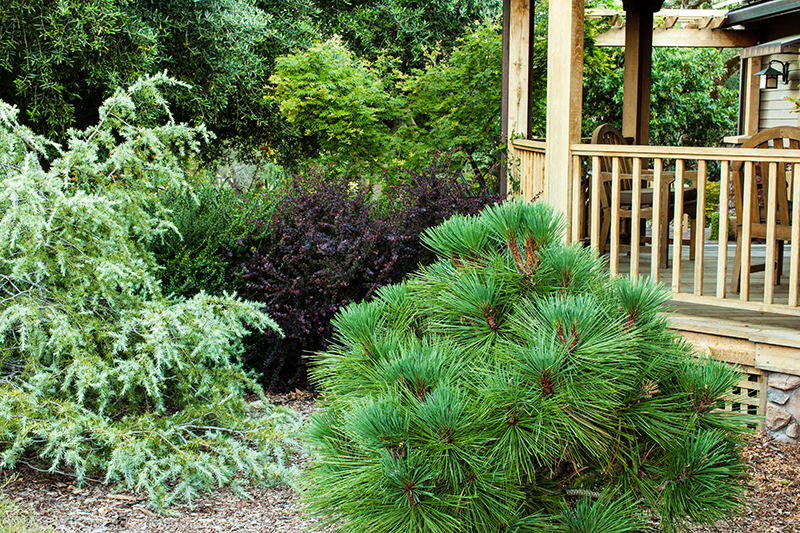
9. In California, planting natives is all the rage, and what we don't understand is why that never seems to include the conifers? California has over 50 native conifers and many have garden-worthy cultivars. Pinus jeffreyi 'Joppi' gets our vote for one of the best. It has a short, squat habit with long (up to 8"), deep green bristly needles and resembles some kind of troll-like creature. We half expect it to talk to us when we come near. The specimen in the photo above has not been pruned, but we're considering borrowing a technique from bonsai and opening up the structure a bit so that we can see the trunk. This will grow slowly to about six feet tall in 10 years, but it can be kept squat by cutting out the central leader. Don't you want to pet it?
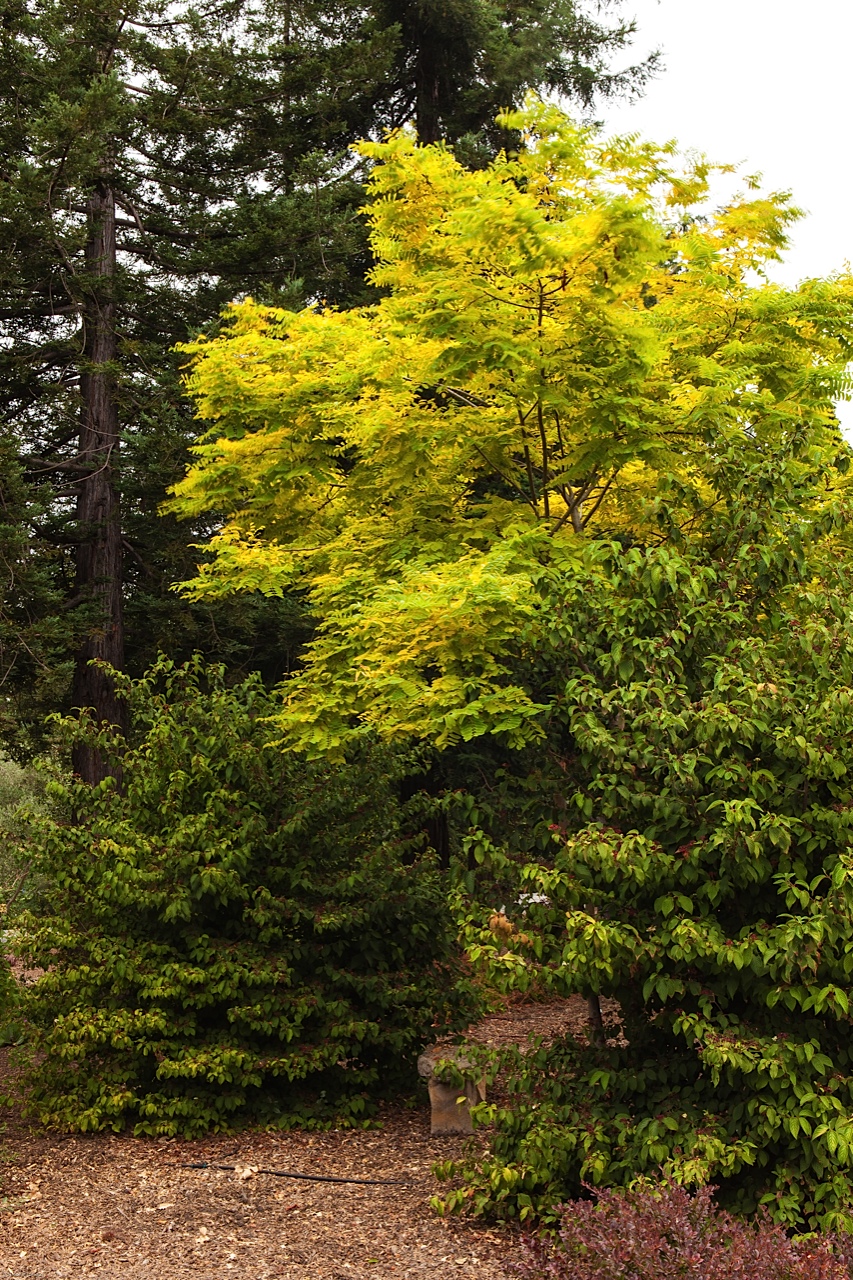
Robinia pseudoacacia 'Frisia'
10. We end this entry with a controversial choice: Robinia pseudoacacia 'Frisia'. 'Frisia' is a large, fast-growing tree that not all gardens can accommodate. Some say it self-sows almost to the point of invasiveness; we have never found it so here, with our drip irrigation and sumptuous mulching. Others complain about the brittle branches--again, they have never presented a problem for us. We do some pruning to tidy it up but other than that we leave it alone. The key to making this tree work in your garden is having enough space for a large tree, and preferably siting it against a backdrop of darker foliage, such as the redwoods in the photo. Some do regularly prune it hard and use it as a large shrub, but we prefer the graceful canopy and the dappled shade that it creates. The light underneath is golden and bright. 'Frisia' only gets more beautiful in autumn, when its chartreuse foliage softens to a creamy golden yellow. It rivals the Ginkgos for its beacon-like effect as the days shorten at year end.
This post has not been tagged.
Permalink
|
|
|
Posted By Admin,
Tuesday, June 20, 2023
|
By: Web Editor
September 30, 2013
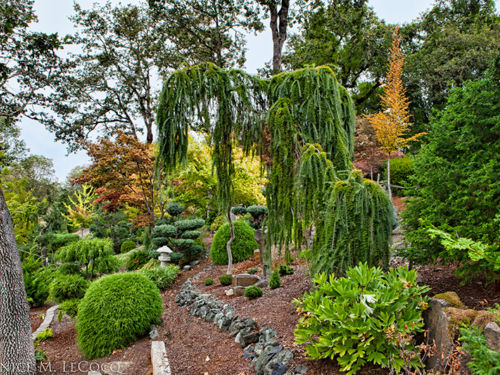
Visits to botanical gardens and nurseries allow us to revel in the scope and breadth of their plantings or to view imposing and impressive mature specimens. Visits to such places can be educational and inspiring, but they can also be daunting, for few if any of us can hope to replicate their grandeur and scale.
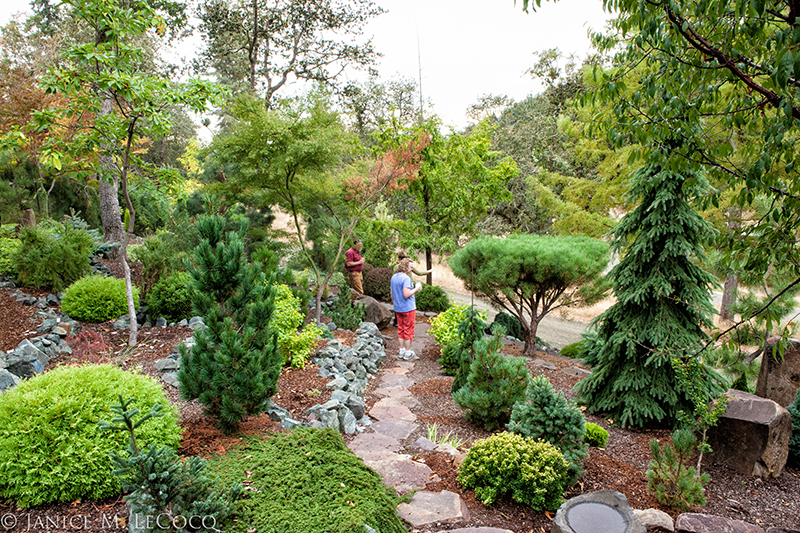
That’s why we also like to visit private gardens, such as that of Ken and Elena Jordan in Roseburg, OR. Their garden, while enormous and ambitious by most standards, is constructed on a more intimate scale, and demonstrates the owners’ personality and connection to their residence that is characteristic of the most successful private efforts.
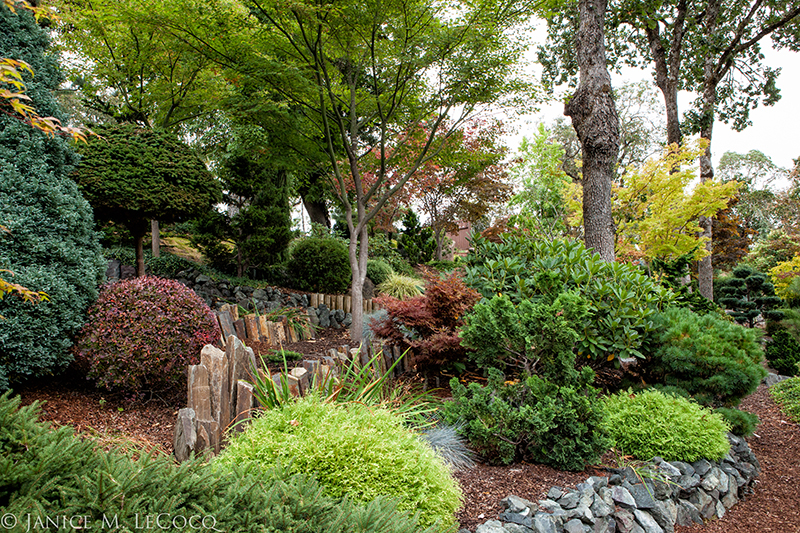
The Jordans sited their house on a bluff overlooking the Umpqua River. Ken designed and built the Craftsman style home himself, and the couple made their garden on the wooded slope facing away from the river, under the remnants of the native forest.

The steeply sloping lot posed design and circulation challenges which the Jordans met by making switchbacked paths and stone retaining walls. Native stone is also incorporated into the garden in the form of boulders and pathways. Both Ken and Elena have design and horticultural talents, and a sense of humor that has caused them to name the property ‘Stonehedge’.

The steep slope could prove tiring to navigate if it were not for the many seating opportunities along the paths. Each spot provides a different aspect, with different vistas and plants to enjoy. Ken's mastery of both the wood shop and the forge are evident everywhere.
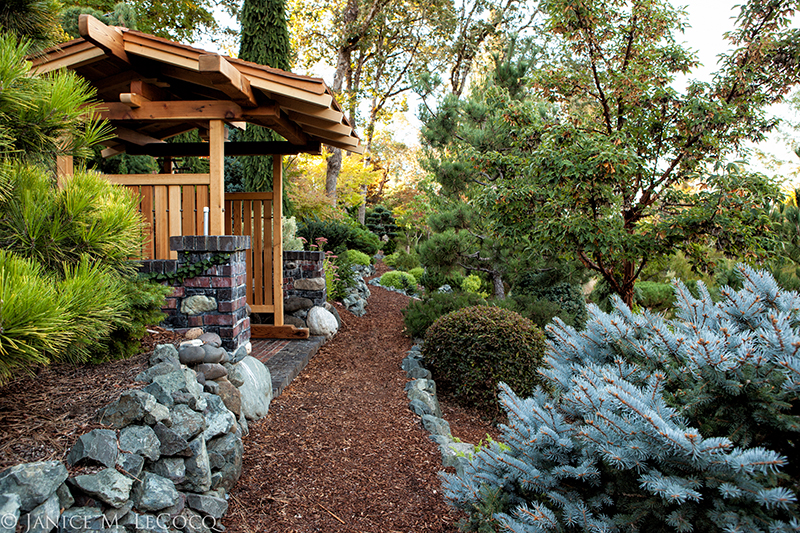
Ken designed and built this structure - the perfect place to sit and enjoy the view and the plantings.
Despite the structures, stone and art, in this garden the plants rule. The Jordans were bitten early on by the conifer bug and with encouragement from Larry Stanley of Stanley & Sons Nursery, made their garden around their large conifer collection. They are active members of the American Conifer Society and travel all over the world to view--and acquire--choice specimens.

Although the Jordans like all manner of conifers (and many foliage plants such as Japanese maples), their property really showcases the large, contorted cultivars such as Pinus strobus 'Pendula' and Cedrus atlantica 'Glauca Pendula' and they have several choice specimens of each.

The contorted trunks of the weeping specimens are beautiful in their own right, and provide 'small moments' to enjoy that balance the scale of the sweeping beds and pathways.

As much as they love conifers, both Ken and Elena know that good design requires contrasting colors, textures and forms, and have interplanted the conifers liberally with deciduous trees such as Japanese maples and beech. Fall is a particularly beautiful time in this garden as the fiery colors of the maples are dramatically set off by the greens and blues of the conifers.

Autumn's low sun shines through the maples and casts a glow over the entire garden, lighting the chartreuse, green, blue and teal conifers.
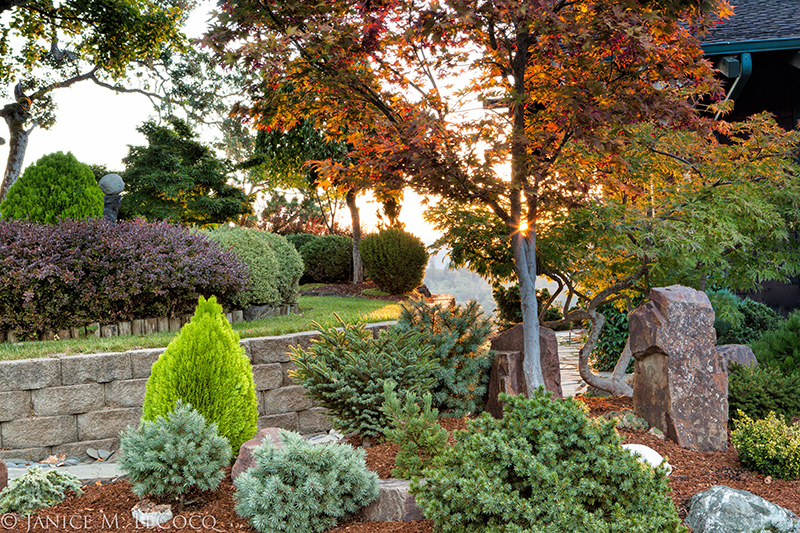
In fact, that sunset drew us right up the slope and around to the back of the house, where we turned from looking at the beauty that the Jordans had created to enjoying the natural view over the river. What a paradise Ken and Elena found when they chose this spot, and what a masterpiece they have created! We look forward to visiting again soon.
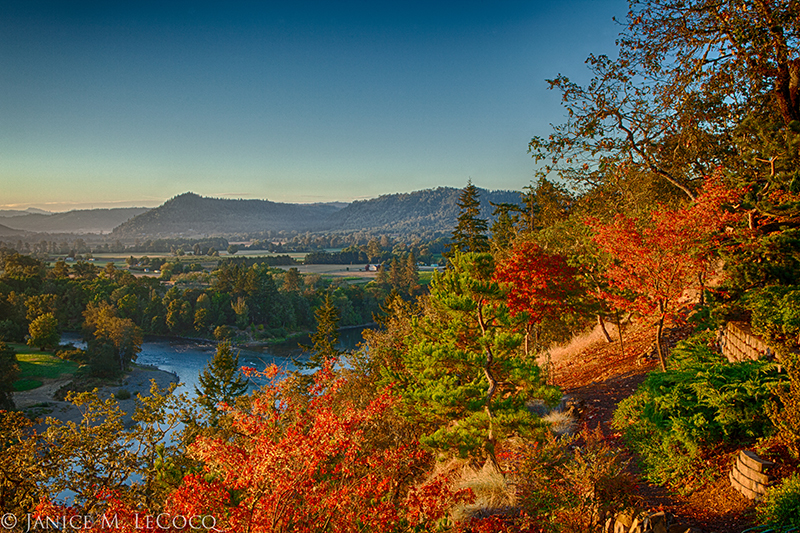
This post has not been tagged.
Permalink
|
|
|
Posted By Admin,
Tuesday, June 20, 2023
|
by Web Editor
December 16, 2015

Helleborus argutifolia, Abies procera 'Glauca Prostrata' and Cotoneaster horizontalis
A couple of months ago we visited Glacier's End Arboretum, in Olympia, WA, where we found that we kept wanting to touch the plants! It wasn't just that the shapes and colors were striking; the textures made us feel like we were in a petting-zoo.
The well-textured garden is delightful in all seasons. While we think of texture as a component of how something feels, texture also affects appearance. Texture can be fine or coarse, matte or glossy. The above trio contains a large-leaved (coarse), glossy hellebore, a small-needled (fine) matte fir and a very fine-leaved glossy cotoneaster. Lots to interest, even without the lovely colors!
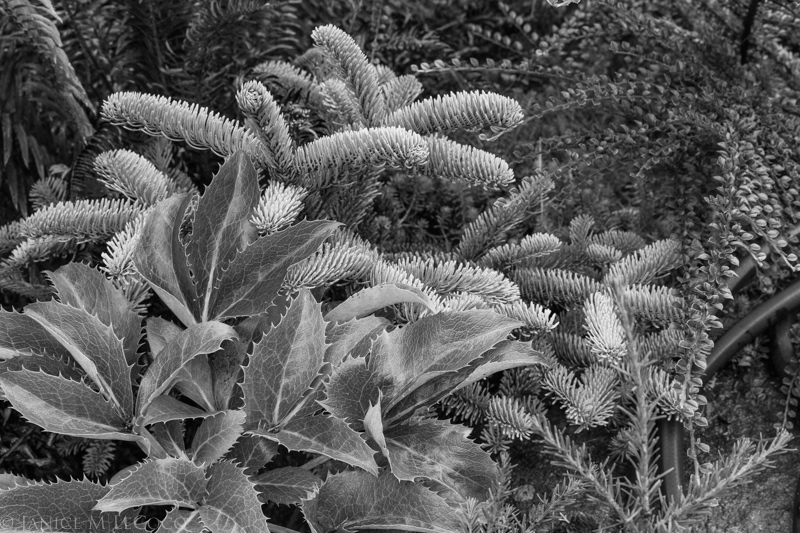
Eliminating the color does not decrease the textural variation; it actually enhances it, with the fir's needles bristling and the glossy hellebore continuing to shine. Now, what about color variation without different textures?
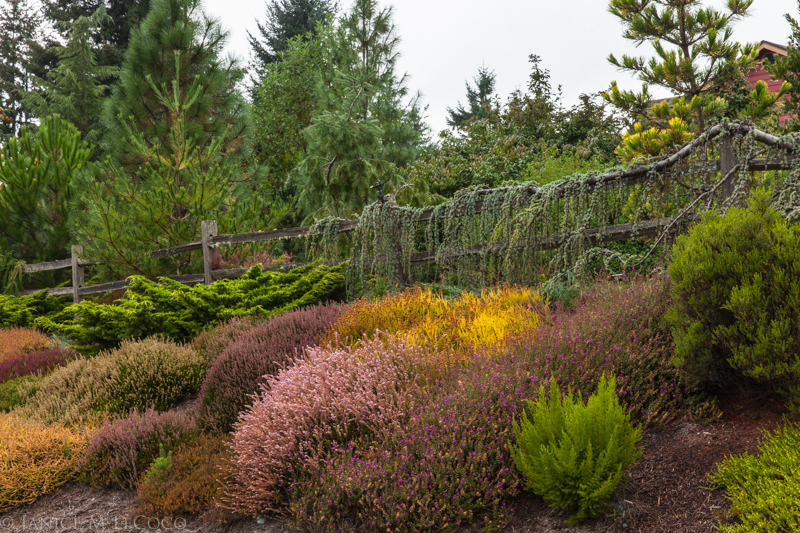
Visitors to Glacier's End are greeted by a beautiful bank of mixed heaths and heathers backed by a living fence of Cedrus atlantica
The colors of the heathers are striking and the fact that they (and the cedar) share the same fine texture does not diminish the loveliness of the planting. However, if you remove the color, you flatten the effect and reduce the impact.
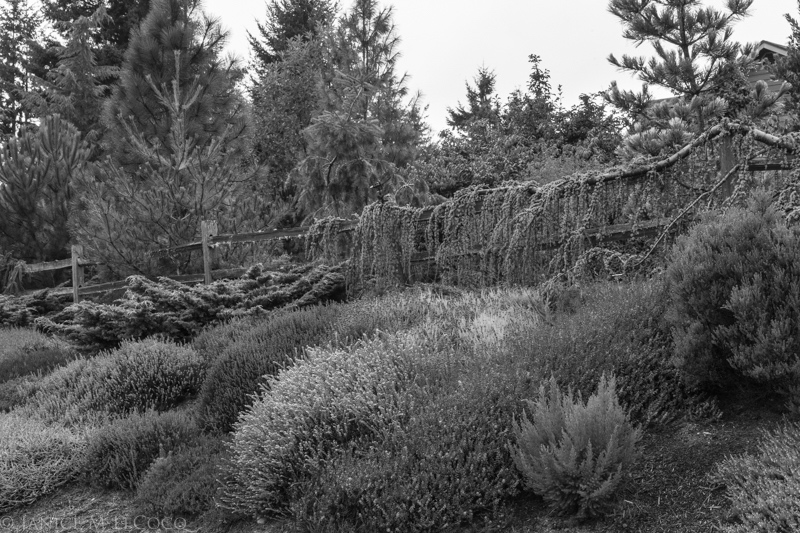
When most of us begin to garden we are attracted first to color and tend to think of garden design and plant selection with color as the sole attribute, usually flower color. As we approach the shortest day of the year and the time when gardens are mostly bereft of flowers, it is a good opportunity to consider how to make our gardens interesting and inviting all year long.
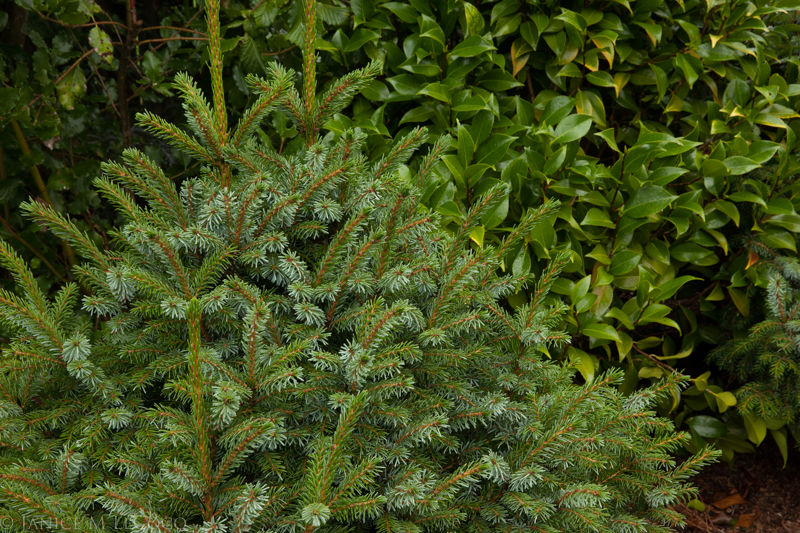
Texture alone makes an impact; the Picea omorika 'Nana' needles contrast beautifully with the glossy leaves of the Camellia
The photo above illustrates the most basic of textural combinations: pairing matte needles with coarse, shiny leaves.
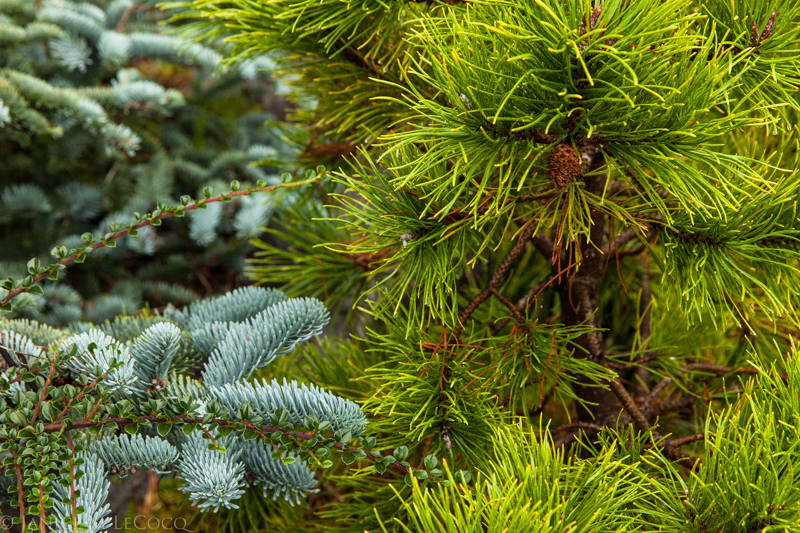
Color amps the effect: there's that powder-blue Abies procera 'Glauca Prostrata' again, this time paired with a Pinus contorta var. latifolia
Texture is a continuum. The plants in the above photo are both technically fine-textured, but the Abies has short, stubby whiskers and the pine's needles are wispy threads. The twigs and stems add a tougher grace note. Yes, it's hard to ignore the color, but texture is unwilling to cede the floor completely.
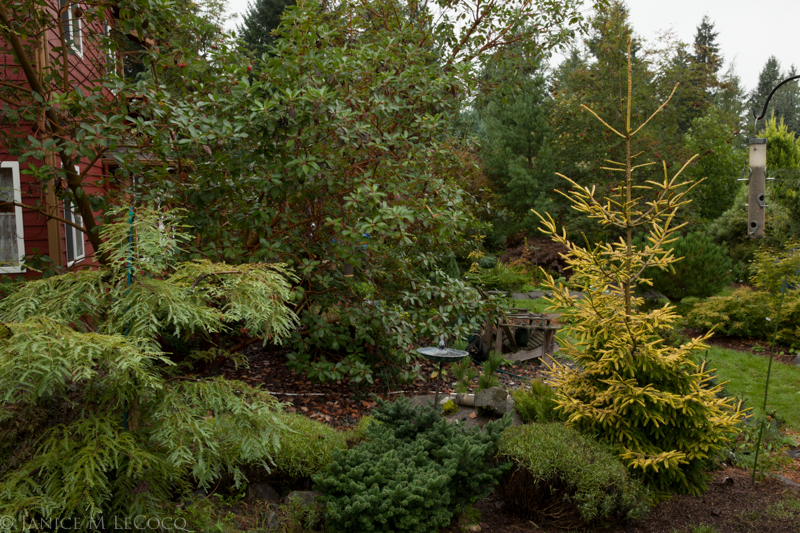
A mixed border of conifers and broadleaved evergreens. Shapes and colors (especially that Picea orientalis
Glacier's End is primarily a conifer garden. Mixing conifers, which generally have needles, thus are fine-textured, with broad leaved, coarsely textured, plants is an easy way to create interesting combinations that are attractive and eye-catching all year round.

Crytomeria japonica 'Elegans Compacta' and Corylopsis
Most Cryptomeria (the shrub on the left in the photo above) take on lavender or rusty hues in winter; the two tones of this one match the Corylopsis spicata leaves and stems. We'd like to give a gold star to the garden makers, who not only got the color combination right, but created a marvelous contrast of opposite textures.
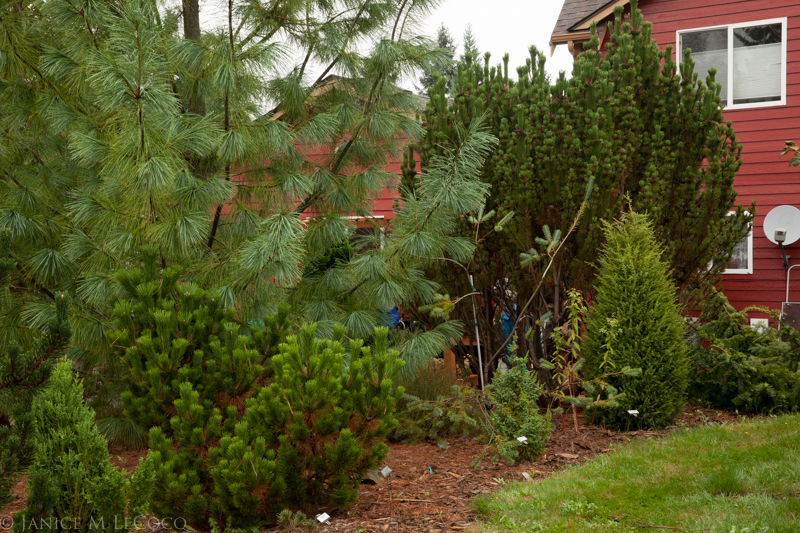
You can even create textural variety within one group of plants. For example, pines can have needles that are long or short, bristly or wispy, dense or loose, upright or droopy, even matte or shiny. All affect the way that light and wind interact with and intensify the textures.
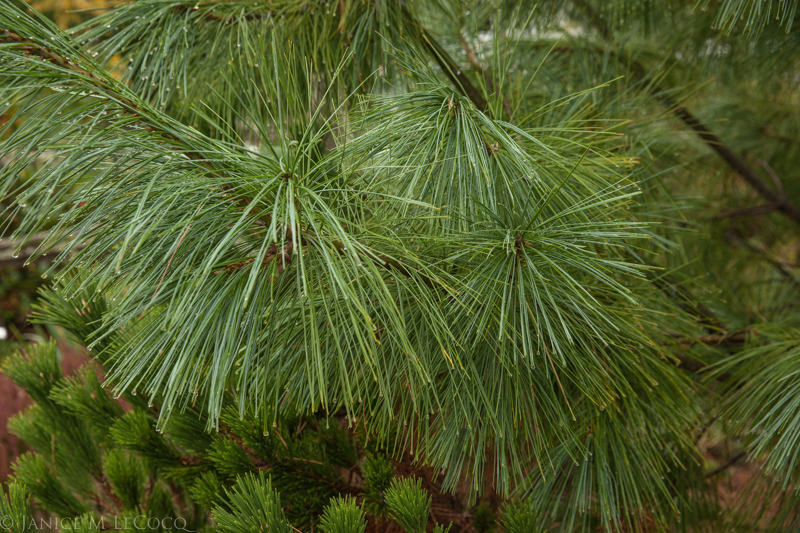
Pinus wallichiana, Bhutan pine, is probably the loveliest of the temperate pines, with long, drooping, feathery needles. Underneath sits its cousin, Pinus thunbergii
Textural differences can be very subtle, and structure, size and orientation play parts as important as color. It also depends on distance. Fine differences such as in the above photo are only apparent when you get close to the plants. Isn't it wonderful that as you approach, the plants become more interesting?
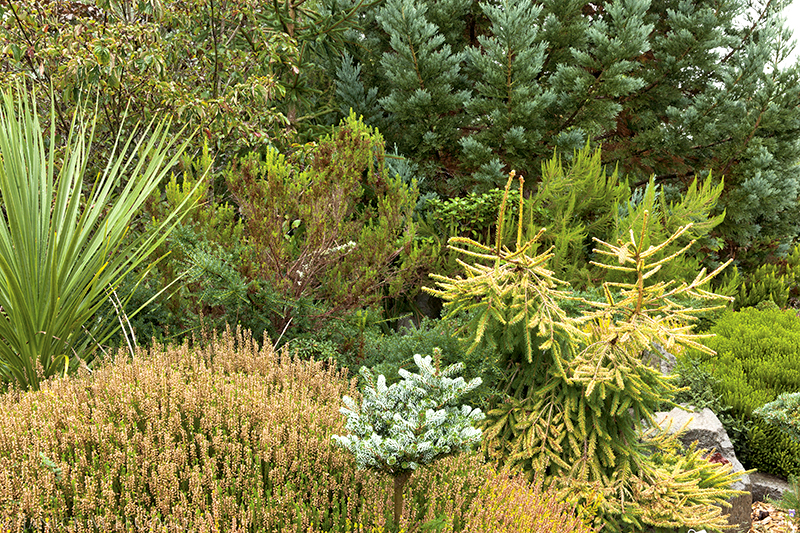
Plants with blade-like leaves, such as this Yucca
Plants with strappy leaves like Dasylirion, Yucca or Phormiums add coarseness to an otherwise finely-textured combination. The conifers and heathers in the above photo are anchored by the coarser Yucca and, we note, the stone.
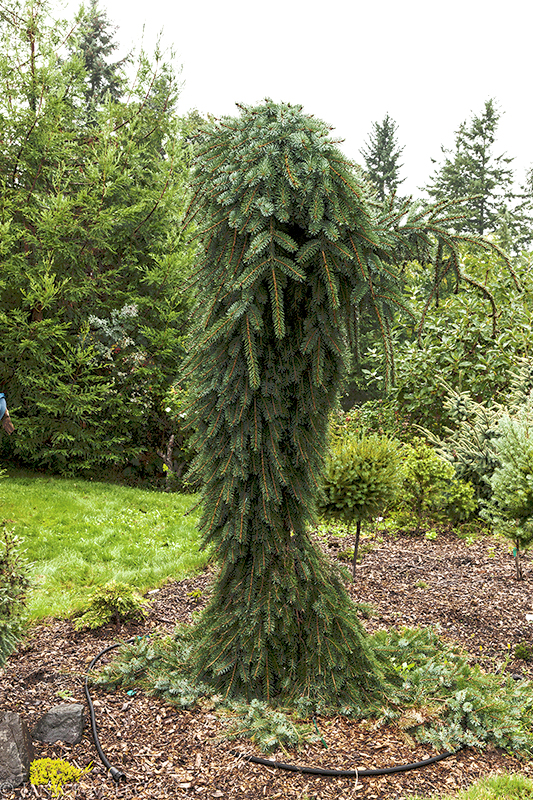
Sometimes a single texture can be on display as with the Serbian spruce above. The foliage begs to be touched.
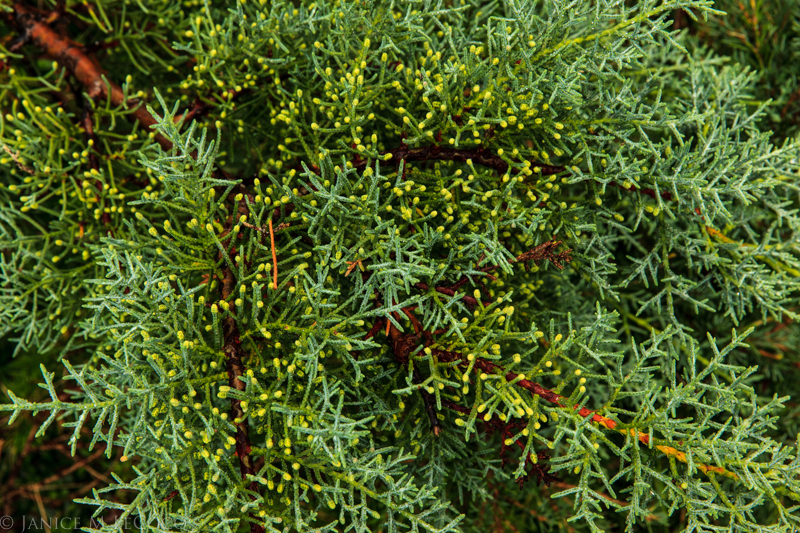
Cupressus glabra var. arizonica
Similarly, without help from others, 'Raywood's Weeping' Arizona cypress provides a virtual explosion of texture, with immature pollen cones lighting up the tips of the branchlets.
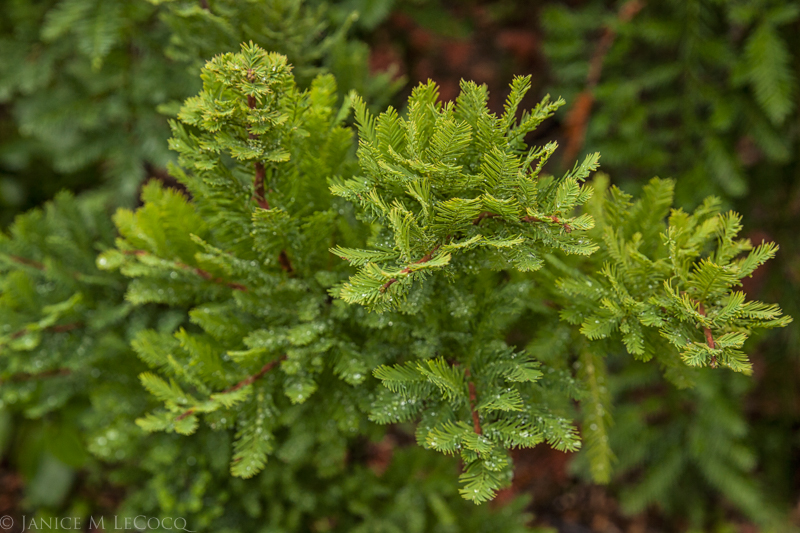
Taxodium distichum
A garden's textural highlights vary with the seasons. Most of the plants at Glacier's End are evergreen, but even with deciduous plants you can have texture in winter, when it often comes from bark and stems.
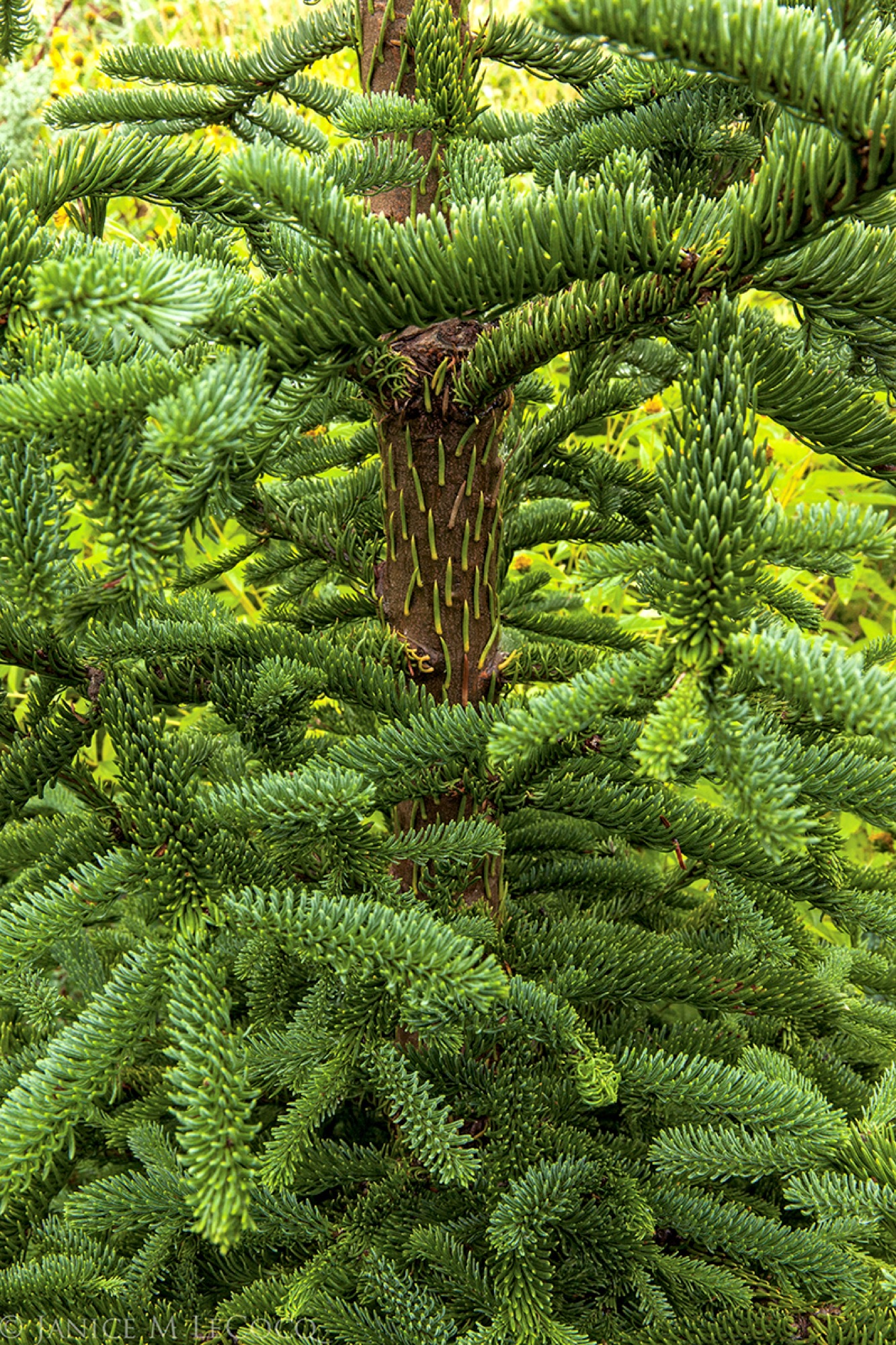
The needled trunk of Abies procera
And don't forget hardscape when creating textural contrasts in your garden. Stones add coarseness and heft that offset the fine needles and small leaves of the nearby plants.
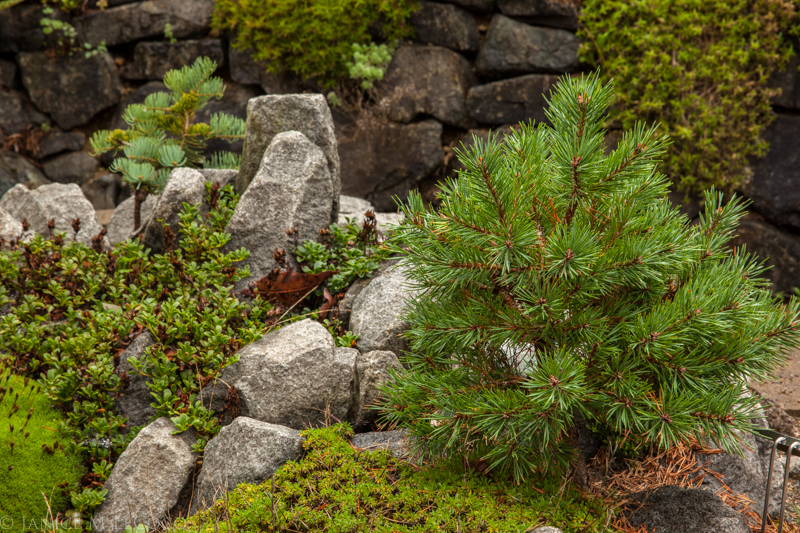
We don't want you to forget about color and we don't want you to forgo form and structure. We just want you to add texture to your garden to-do list. Make a New Year's resolution to texturize your garden in 2016!
Glacier's End Arboretum is a private garden in Olympia, WA.
This post has not been tagged.
Permalink
|
|
|
Posted By Admin,
Tuesday, June 20, 2023
|
By Jerry Kral
July 23, 2020

Clematis pitcheri in Cryptomeria japonica ‘Araucarioides’
Most of us wouldn’t dream of messing with a wonderful conifer specimen. They sit there in the sun regaling us with their colorful foliage or unique texture. Some stand alone or are nicely grouped with complementary conifers. Often, a non-conifer may be invited to join the party. What else is needed? May I suggest a little “bling”?
I don’t mean going around adding necklaces, rings or frosting conifer foliage with sequins. I’m referring to botanical jewelry such as a non-obtrusive necklace of a delicate vine. A properly used vine can add interest and draw even more attention to a specimen conifer or conifer grouping, such as in the image above, where the 'Aurea' Japanese cedar wears some Clematis finery.
Vines used as conifer necklaces need to meet some requirements. They must be delicate enough not to smother the plant. They must not climb by twining so they can be easily removed at the end of the growing season and not add extra snow or ice load in the winter. I’ve enjoyed playing with one vine that is rarely seen and meets all the requirements
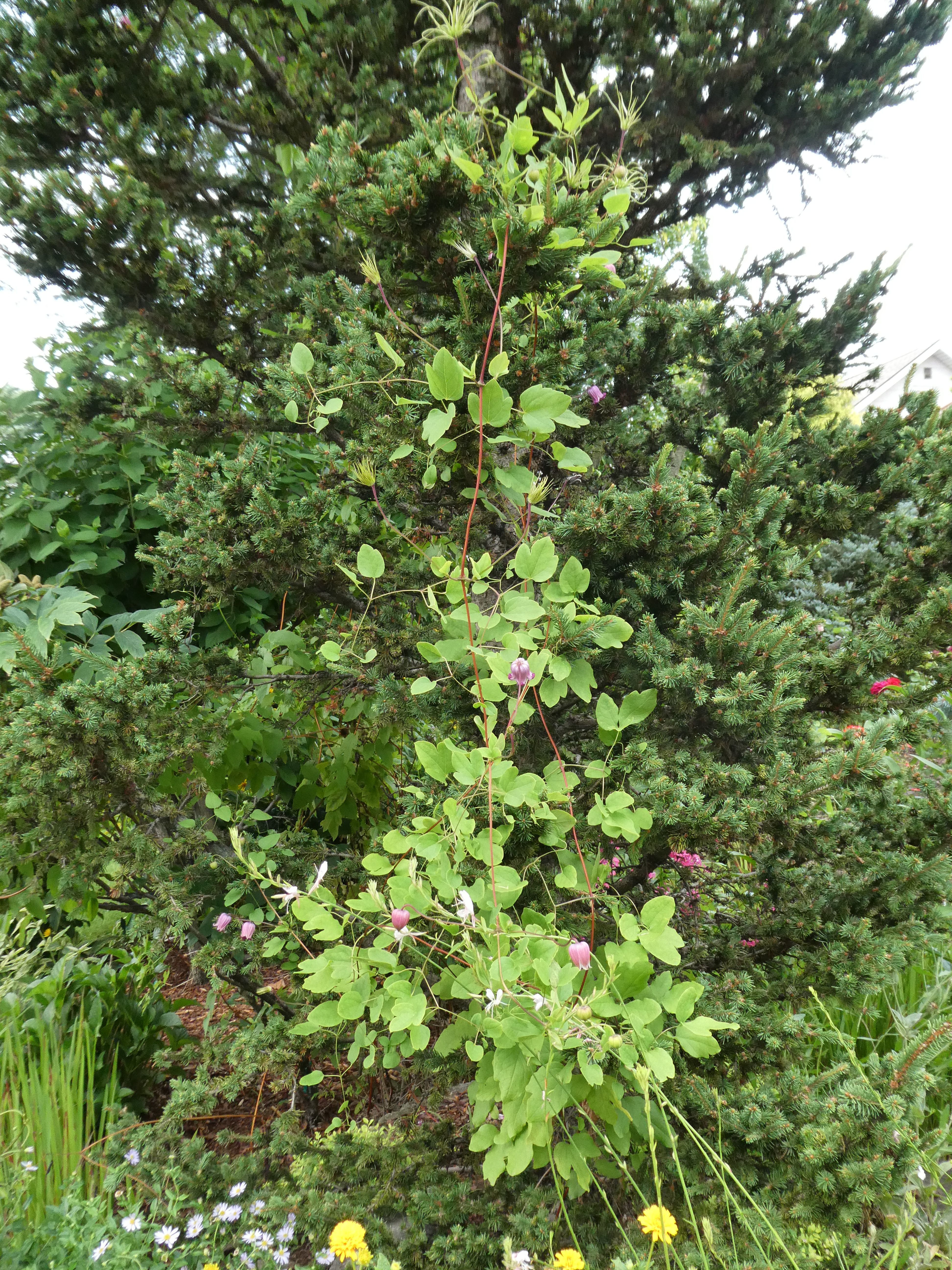
Clematis pitcheri in Picea abies ‘Hillside Upright’
Clematis pitcheri (purple leather flower) is native to the Midwest, ranging from Iowa and Illinois to Texas. Pruning is not an issue. It is a perennial vine, freezing to the ground at the first killing frost. Just cut it at the base after the top freezes. In spring it will send up 3-4 sprigs that can eventually clamber 15-20 feet in a season. These emerging sprigs are brittle, so support them until the petioles clasp onto a conifer branch. Each vine shows little tendency to branch so it is unlikely to smother any conifer, certainly not the Hillside Upright Norway spruce.
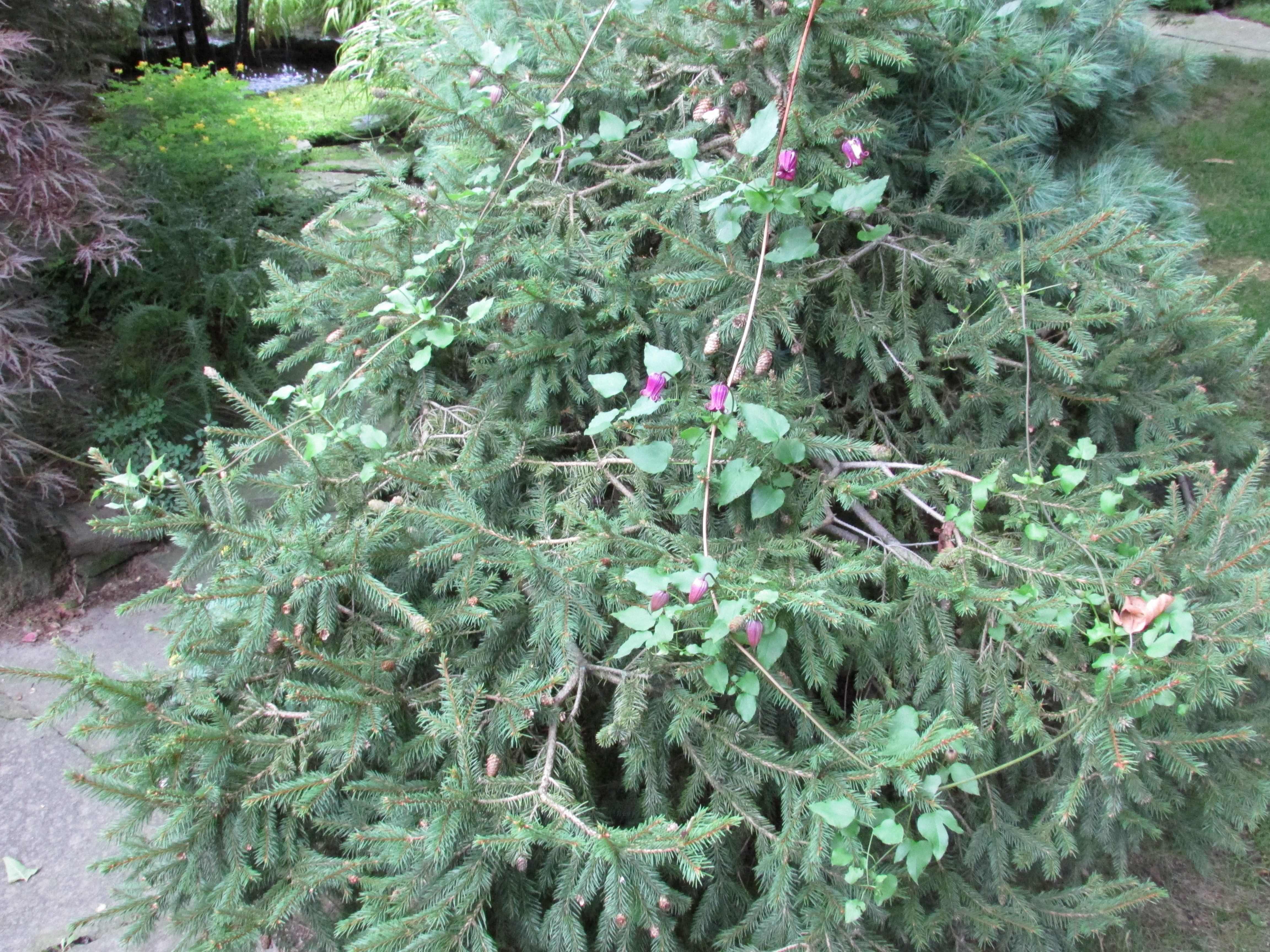
C. pitcheri on Picea abies ‘Pusch’ The vine is rooted 15’ away!
The small, purple, pitcher shaped blossoms are continuously produced from late May until frost. There are no selected cultivars. Species variation produce flowers from light purple to dark purple. Some will even show white edges on the petals. The following three photos show some of the flower color variation within the species:
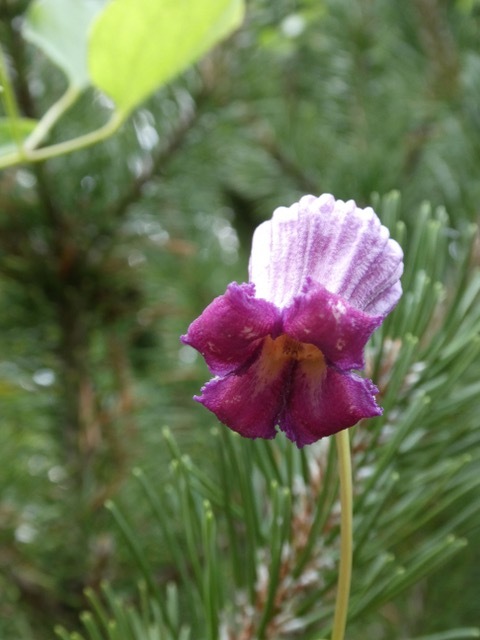
Clematis pitcheri with deep mauve flowers
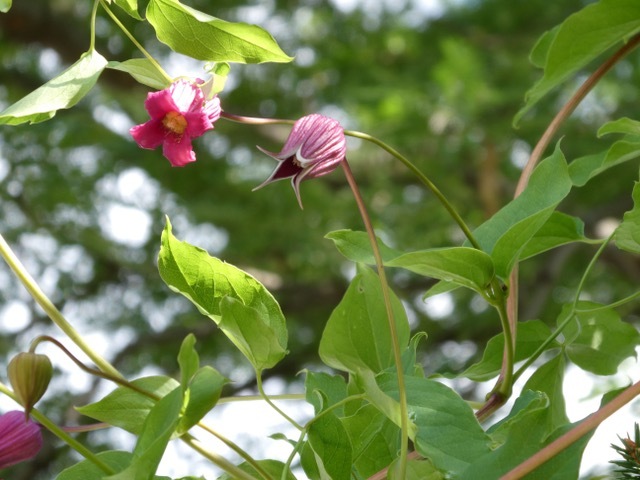
Clematis pitcheri flowers with a redder tone

A bumble bee inspects the soft, pink and cream flowers of Clematis pitcheri
Since the vines are mostly unbranched and don’t twine, they can be easily pulled out of even the most delicate conifer. This species is sun loving, so will clamber on the top of even the smallest dwarf conifer. Once established, it is quite drought tolerant. And, if that isn’t enough, being a small flowered clematis, it is almost immune to clematis wilt! And, even better, rabbits and deer may find it slightly poisonous.
C. pitcheri likes well drained soil with consistent moisture. It is especially fond of alkaline soils, however, mine do very well in slightly acid soil mulched with pine bark. I even get 3-4 seedlings a year.
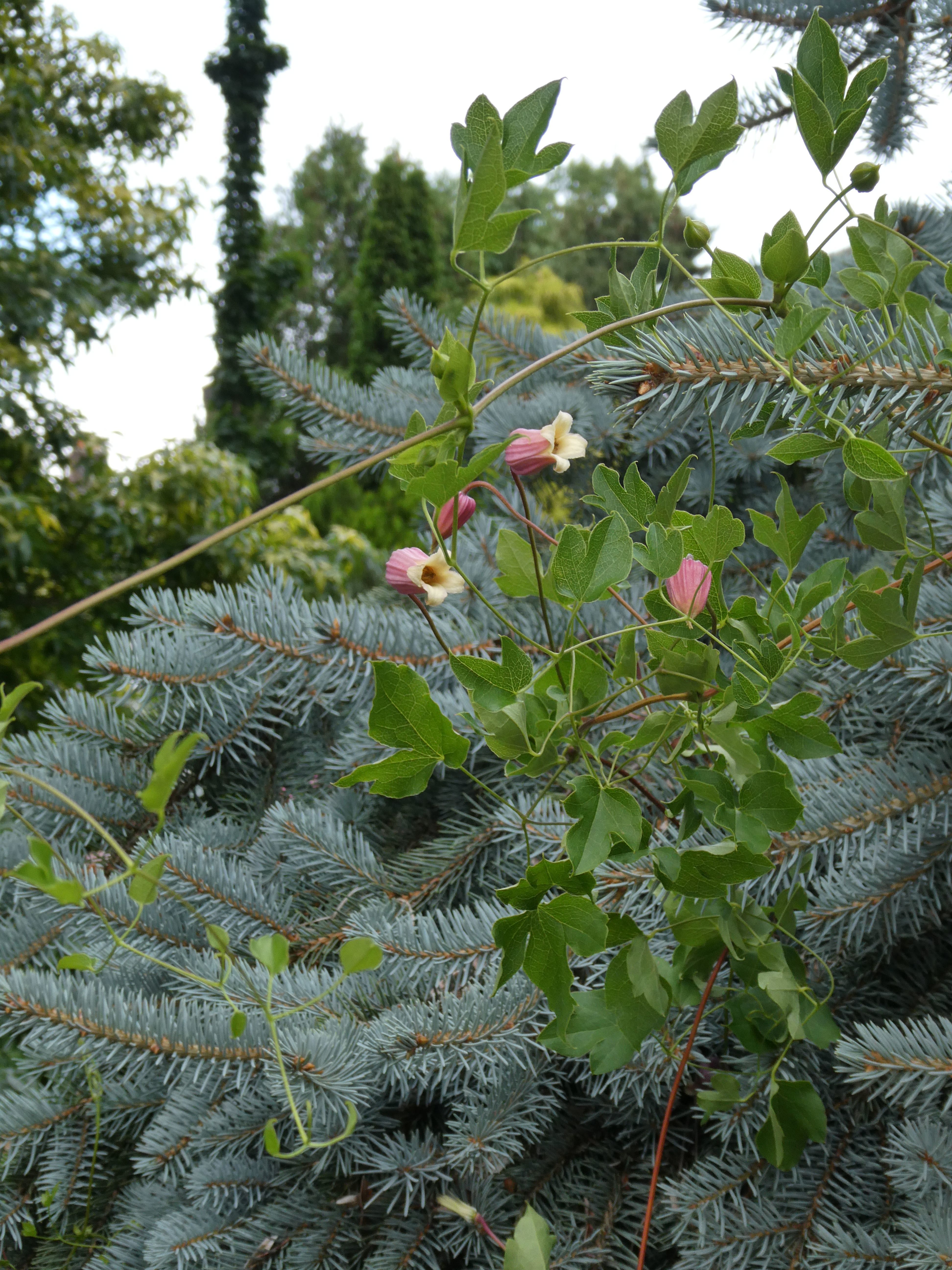
C. pitcheri scrambling atop a Pinus strobus ‘Minuta’
The purple flowers go beautifully with the blue-green needles of the Pinus strobus 'Minuta' (Minuta Eastern white pine).
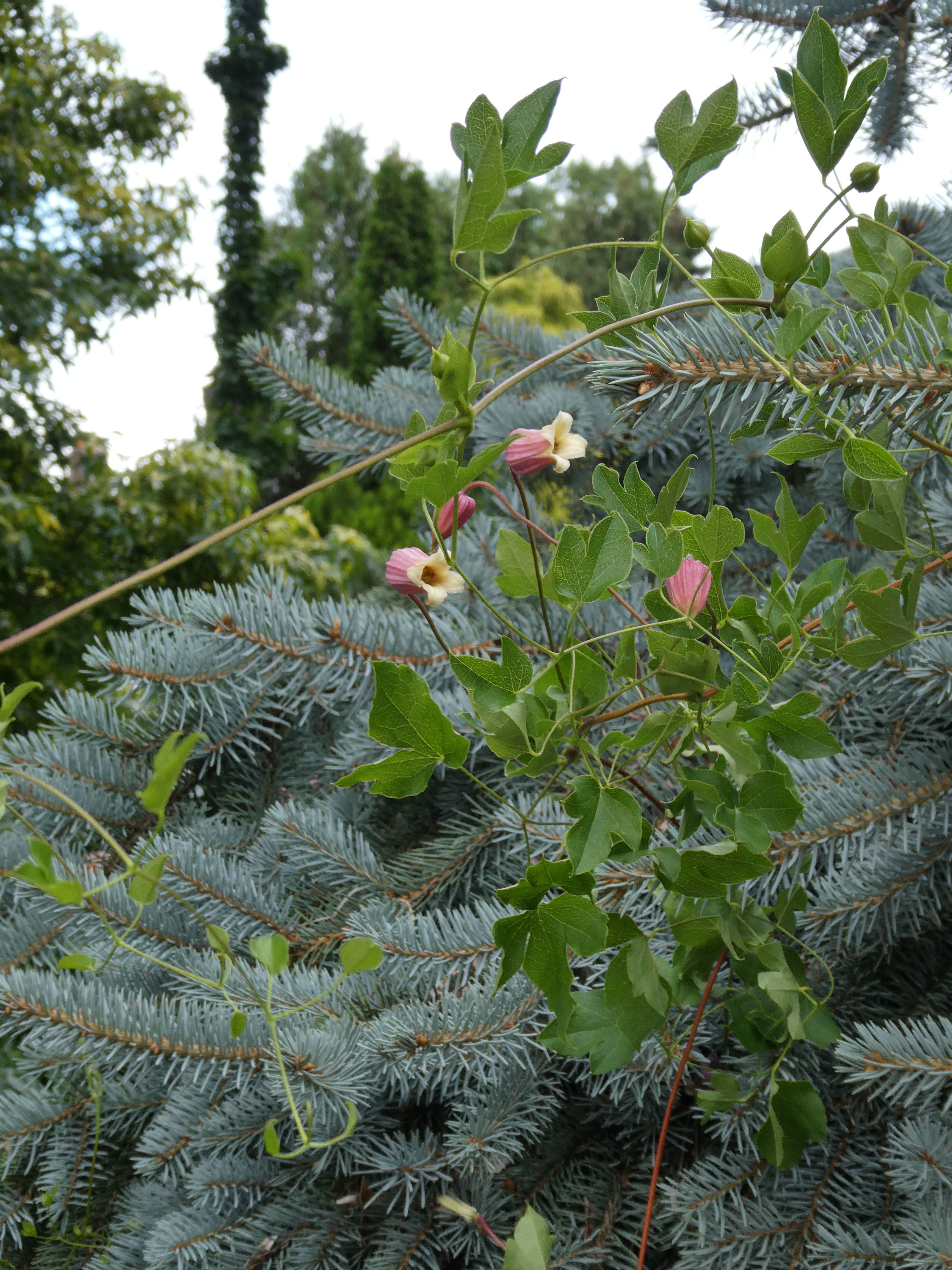
C. pitcheri on Picea pungens ‘Glauca Procumbens'
The lighter flowers and the baby-blue needles of Picea pungens 'Glauca Procumbens' produce a softer look.

C. pitcheri on Pinus mugo ‘Paul’s Dwarf’
Paul's Dwarf mugo pine is a garden stalwart but is not above being bedecked with finery!
I’m sure there are many other tree and shrub friendly vines that can add that bit of bling to a specimen conifer and interest to your garden. Purple leather flower is so user friendly I have not tried any others, but you should investigate what vines grow in your climate that have the same habit. I usually have 2-300 visitors tour my gardens each year, and my use of this unique clematis seems to surprise and delight even the most jaded garden visitor. So do your thing and add some bling!
Jerry Kral is a longtime ACS member who gardens in Rochester, NY.
This post has not been tagged.
Permalink
|
|
|
Posted By Admin,
Monday, June 19, 2023
|
By Web Editor
August 19, 2018

Chamaerops humilis var. argentea
When the weather is hot, we look to cool blues for relief. We've written about blues in autumn, when they contrast strikingly with the fiery colors of the changing foliage, but in summer, especially late summer when we are tired of the heat, we like a splash of blue almost anywhere. The palm pictured above is hardy to about 10 degrees fahrenheit, so it is not a tropical. It's short and clump-forming, so easy to mix with other kinds of plants.
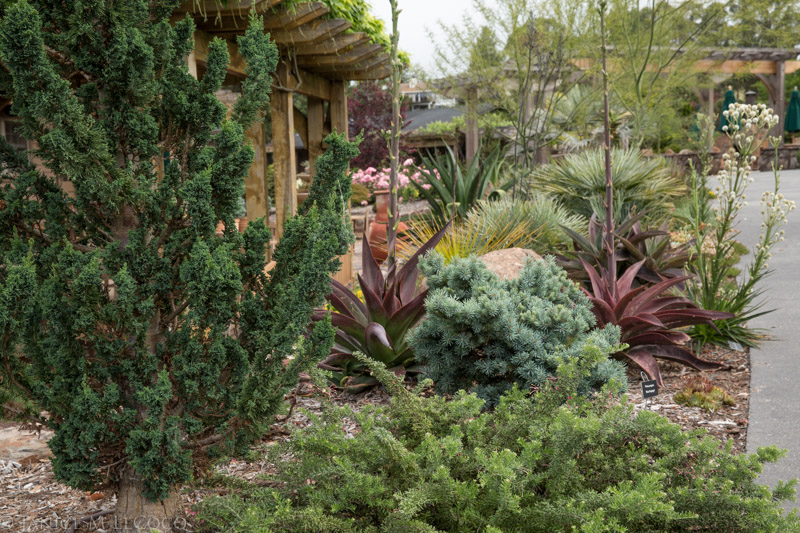
Blue repeats through the border from the Picea pungens to the Chamaerops to the Brahea at the far end.
There are lots of blue palms, many of which are cold-hardy. For a bigger plant with specimen status, try the Mexican Brahea armata.
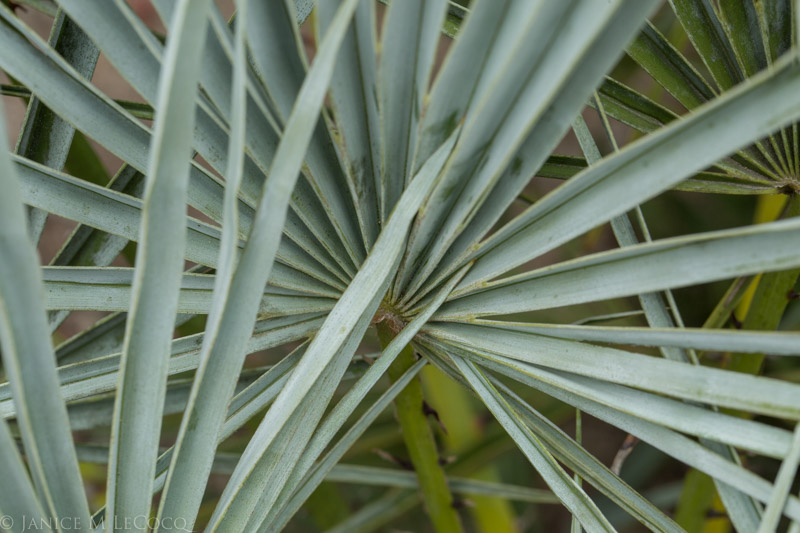
Brahea armata
Palms provide a very different texture and structure than other plants. Because we think of them as tropical, we hesitate to mix them with temperate species. But many palms are also temperate and grow happily among conifers and succulents in their native ranges.
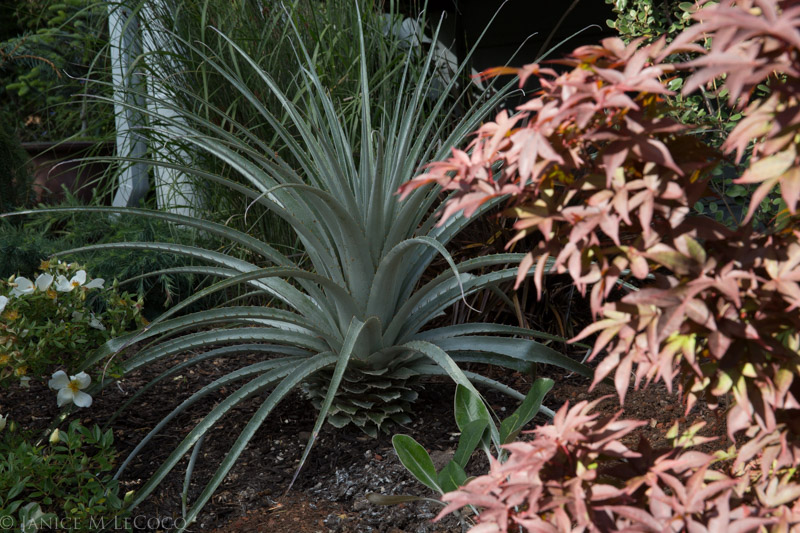
This silvery blue Puya
There are lots of succulents and succulent-like plants in shades of blue. You can also add blue with pots or other ceramics.

Many rocks have blue tones and can help keep the apparent temperature down. In this garden in Roseville, Oregon, the stonework gets outdone by the spruce, though!
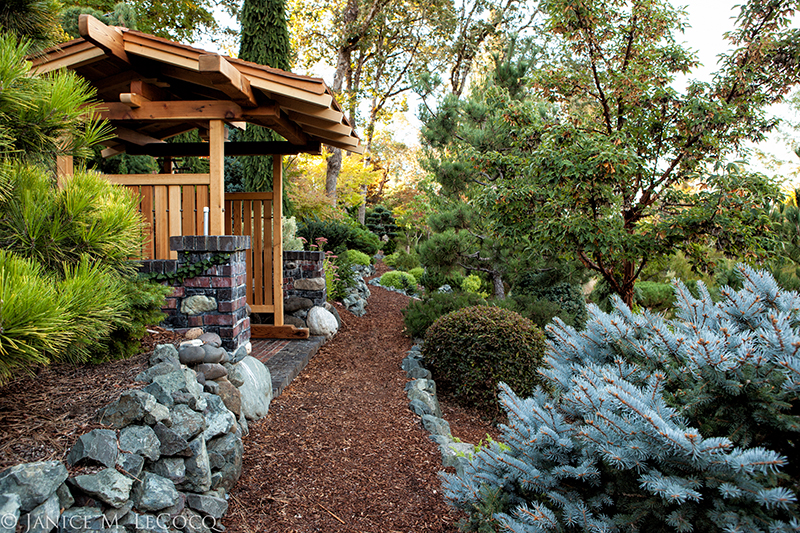
There are many blue conifers, beginning with Colorado blue spruce (Picea pungens). There is probably not a more maligned suburban landscape tree, due to the enormous size the species attains. Happily, there are many cultivars that are slow-growing and garden-friendly. In the shot above the spruce cools down the entire garden.
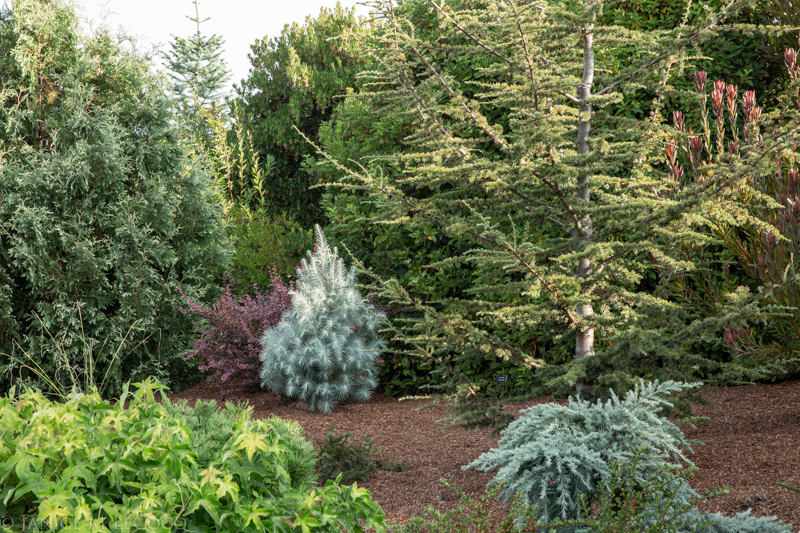
Cedrus deodara 'Feelin' Blue', Cedrus atlantica 'Sahara Ice'
The blue comes from waxes that the plant carries outside its leaf cuticles, which retard absorption of certain wavelengths of light.
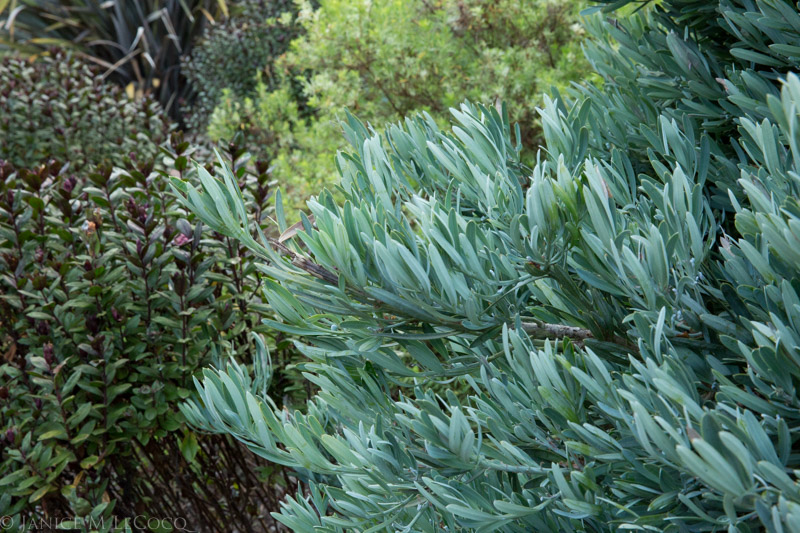
Podocarpus elongata
For those that can grow it (it's tender), Podocarpus Icee Blue is the ultimate summer cooler. A blade-leaved conifer (instead of needles), it works with a multitude of shrubs to bring down the hot summer temps.
So plant blue to cool down your summer and heat up your fall.
This post has not been tagged.
Permalink
|
|
 WR President
WR President SER President
SER President SER Director
SER Director WR Director
WR Director ACS President
ACS President ACS Secretary
ACS Secretary ACS Treasurer
ACS Treasurer CR Director
CR Director CR President
CR President